Growing Greener in Your Rappahannock River Watershed

Case Studies and Talking Points on the Economic and Environmental Benefits of "Green Development" Practices
Funded by:
E.P.A. Sustainable Development Challenge Grant
Chesapeake Bay Restoration Fund
Rivers, Trails and Conservation Assistance Program
Friends of the Rappahannock
Table of Contents
Preface/How to Use this Guide/Acknowledgments iv
Introduction vi
Chapter 1- Bioretention
Attributes and Features 1-1
Case Study: Sommerset 1-6
Case Study: Beltway Plaza Shopping Center 1-9
Chapter 2- Wet Ponds
Attributes and Features 2-1
Case Study: Laurel Lakes 2-5
Case Study: Chancery on the Lake 2-8
Chapter 3- Filtration/Infiltration
Attributes and Features 3-1
Section A- Sand Filters
Attributes and Features 3-A-1
Case Study: Duke St. Square 3-A-5
Section B- Infiltration Chambers
Attributes and Features 3-B-1
Case Study: Capital One 3-B-4
Case Study: Belmont Bay 3-B-7
Chapter 4- Stormwater Wetlands
Attributes and Features 4-1
Case Study: Fredericksburg Christian School 4-5
Chapter 5- Low Impact Ponds
Attributes and Features 5-1
Case Study: VDOT Headquarters- Lottsburg, VA 5-3
Chapter 6- Open Vegetated Channels
Attributes and Features 6-1
Case Study: See Sommerset and Northridge case studies. 1-6 & 9-5
Chapter 7- Streambank Restoration
Attributes and Features 7-1
Case Study: Massaponnax Creek at Lee's Hill 7-4
Case Study: Massaponnax Creek at Southpoint 7-7
Chapter 8- Riparian Buffers
Attributes and Features 8-1
Case Study: Fawn Lake 8-4
Chapter 9- Open Space Development
Attributes and Features 9-1
Case Study: Northridge 9-5
Case Study: Farmcolony 9-9
Case Study: English Meadows 9-13
Chapter 10- Special Golf Course Techniques
Attributes and Features 10-1
Case Study: Belmont Bay 10-3
References R-1
Selected references sorted by topic R-7
Additional internet references and phone contacts R-11
Preface
Can economic growth and good environmental stewardship be compatible goals? Across the region and the country, more and more examples are emerging where developers have benefited economically from "going the extra mile" in designing their projects. We hope that this document will be the centerpiece of effective dialogue that ultimately results in greater use of innovative Best Management Practices (BMPs) throughout the Rappahannock River Watershed.
The real-world case studies of developments in this document are intended to help land developers and site designers become familiar with the practical, hands-on implications of the somewhat nebulous concepts of "sustainable" or "green" development. None of the practices presented herein represent a "silver bullet" that reduces all environmental impacts while also helping or maintaining the developer's bottom line. However, each practice and case study provides a piece of the puzzle, a new angle on the practicality and feasibility of good stewardship in the design of new developments.
How to Use this Guide
This manual is divided into chapters. Each chapter addresses an individual BMP and contains two parts. The first part presents the BMP itself and gives information on design, construction, maintenance, pollution removal, costs and benefits. The second part presents a case study of a development in which this particular BMP was used and the specifics on construction, maintenance, costs and benefits. References are given as parenthetical documentation and listed alphabetically at the end of the entire document.
Please note that all the references listed in this manual can be found in the Friends of the Rappahannock's library and are available for use by local developers, planners, architects, environmental scientists and engineers. We welcome area professionals to come by to discuss their projects and utilize our resources.
Acknowledgments
We would like to thank all the experts in the development, engineering, planning and environmental science fields who contributed to the synthesis of this guidebook. Preparation of the handbook would not have been possible without their generosity and expertise. A special thanks is deserving to the following individuals for their time and guidance. Hal Wiggins of the USACE for his information on Fawn Lake and the Massaponnax Creek restoration projects, David Tice of David Tice & Assoc. for his help with the Lee's Hill case study, Bob Pickett of VDOT for his help with the Lottsburg project, R.J. Keller of R.C. Fields, Inc. for his information on the sand filters at Duke Street Square, Larry Coffman and Derek Winogradoff of Prince George's Co. DER for their advice on bioretention and the projects at Sommerset and Beltway Plaza, Bob Kaufman of the Michael T. Rose Companies for his information on Northridge and Laurel Lakes, Rick Thomas of J.K. Timmons & Assoc. for his help with the streambank restoration project at Southpoint, Pat Gassaway for the information on Fawn Lake, Bob Sowder of Sentry Realty for his information on the English Meadows case, Don Thurnau for his information on the Farmcolony case study, Jason Vickers-Smith for his help with the Belmont Bay study and Bob Maestro for information on the Belmont Bay and Capital One studies.
Special thanks is also deserving to the following individuals for their assistance with the content and design of our manual: Tom Schueler of the Center for Watershed Protection, Dave Kitterman of the Fredericksburg Area Builders Association, Warren Bell and Larry Gavan of the City of Alexandria, Jim Stafford of Sunrise Builders, Randall Arendt of Natural Lands Trust and Zeke Moore of Sullivan-Donahoe & Ingalls.
Introduction
Developers can choose from a variety of design and engineering alternatives that can turn what once was considered a necessary evil into a useful, enjoyable, and marketable amenity.
- National Association of Home Builders Land Development Magazine (Hilsenwrath and Zachary 1996)
In the past, stormwater management has been considered an unfortunate necessity by environmental regulators and a costly nuisance by developers and engineers. However, recent advances in the field have illustrated that alternative approaches to stormwater control and land development can be implemented which have both environmental and economic benefits.
How development practices can decrease property values
...because infiltration is impeded, the soil's natural filtration action has little opportunity to cleanse the runoff of pollutants...In addition, without adequate percolation, groundwater supplies can become exhausted... (Hilsenwrath and Zachary 1996)
- National Association of Home Builders Land Development Magazine
Land development has several negative impacts on the terrestrial and aquatic environment. These impacts, which are listed below, can have severe implications for property values and homeowner satisfaction. Stormwater BMPs serve the important role of minimizing the environmental impacts of land development, thus helping to protect real estate property values and the natural environment.
- Increase in flooding and associated property damage due to impervious surfaces.
- Larger export of pollutants (i.e. hydrocarbons from parking lots and fertilizers from lawns) which degrades aquatic resources.
- Increased streambank erosion resulting in property loss.
- Altered aquatic and riparian biota and loss of vegetative cover.
- Decreased groundwater recharge rates that lead to failure of wells and low flow levels of streams, lakes and ponds.
How innovative BMPs in development can increase property values
Developers currently can choose from a variety of innovative approaches that will provide quantifiable economic and marketing benefits by enhancing the aesthetics of their development, result in significant cost savings and protect the environment.
Economic and Marketing Benefits
Perhaps the greatest asset of innovative stormwater management is its potential to enhance the aesthetics of a development. Research has shown that people have a strong emotional attachment to water, and that they are willing to pay significant premiums for property fronting well-maintained bodies of water. Stormwater BMPs allow for the possibility of providing a waterbody for aesthetics, recreation and enjoyment while simultaneously meeting all stormwater control requirements. Other practices retain the exisiting vegetation or mimic or improve the natural landscape. Developers nationwide are realizing the potential of stormwater BMPs and are producing innovative structures that benefit their developments both economically and environmentally.
Survey of residents of Columbia, Maryland (Frederick et al. 1995):
- 75% felt that permanent bodies of water increased property values
- 73% said they would pay more for real estate located in a neighborhood with stormwater control structures designed for fish and wildlife use
- 75% prefer urban runoff ponds which contain permanent pools of water, wetlands, and wildlife over the standard dry ponds
- 94% responded that managing runoff basins for fish and wildlife as well as for sediment and flood control would be desirable
- 92% considered wildlife to be extremely important and expressed that their presence outweighed any nuisances they created
Examples of real estate premiums charged for property fronting urban runoff controls
| Location |
Base Costs of Lots/Homes |
Estimated Water Premium |
|
Centrex Homes at Berkley,
Alexandria, Virginia
|
Condominium $330,$368,000 |
Up to $10,000 |
|
Chancery on the Lake,
Fairfax, Virginia
|
Condominium $129,000 - $139,000 |
Up to $7,500 |
|
Townhomes at Lake Barton,
Burke, Virginia
|
Townhome with lot: $130,$160,000 |
Up to $10,000 |
|
Lake of the Woods,
Orange County, Virginia
|
Varies |
Up to $49,000 |
|
Dodson Homes, Layton
Faquier County, Virginia
|
Home with lot: $289,$305,000 |
Up to $10,000 |
|
Ashburn Village,
Loudon County, Virginia
|
Varies |
$7,500 - $10,000 |
|
Waterside Apartments,
Reston, Virginia
|
Apartment Rental |
Up to $10/month |
|
Village Lake Apartments,
Waldorf, Maryland
|
Apartment Rental |
$5 - $10/month depending on apartment floor plan |
|
Marymount at Laurel Lakes Apartments,
Laurel, Maryland
|
Apartment Rental |
$10/month |
| Fairfax County, Virginia |
Commercial Office Space Rental |
Up to $1/square foot |
Environmental Benefits
As development continues at an ever-increasing pace, we are realizing the need to employ practices that are not only economically feasible but that also protect the enviornment. The environmental benefits of the innovative stormwater practices detailed in this document are listed below.
- Reproducing the hydrological conditions in the stream prior to development, which helps prevent flooding and streambank erosion.
- Providing significant pollutant removal thus protecting aquatic resources.
- Preserving or creating wildlife habitat.
- Minimizing erosion thereby reducing sediment in waterways and preserving quality soil on the ground.
- Recharging groundwater supplies providing base flow to streams, wetlands and lakes.
Bioretention
Bioretention is an infiltration or filtering system that uses natural processes to cleanse stormwater. Over the long term, it can be a less expensive BMP option than stormwater ponds, and has additional benefits such as attractive landscaping, "green marketing" and noise and wind breaks.
In fact, bioretention is a much more cost-effective method for treating paved areas than such structural methods as oil-grit separators.
- National Association of Home Builders Land Development Magazine (Hilsenwrath and Zachary 1996)
Introduction
- Designed to mimic pollutant removal mechanisms of plants and soils present in natural forested ecosystems (Claytor and Schueler 1996).
- Runoff is directed as sheet flow to landscaped depressions designed as parking lot islands, parking lot filter strips or "rain gardens" in residential yards (Claytor and Schueler 1996).
- Composed of a grass buffer strip, ponding area, organic or mulch layer, planting soil, sand bed and designated plants (Eng. Tech. Assoc and Biohabitats 1993).
- Vegetation consists of grasses, mulch, shrubs and trees; about 75-80% of normal landscaping plants can be used (Coffman 1997).
- Water is ponded 6 to 9 inches above the organic layer and infiltrates into the soil or evapotranspires over a 48-hour period (Claytor and Schueler 1996).
- Proper design is important and the same person should be with the project from planning through construction (Pasquel 1999).

Schematic of bioretention filter (Claytor and Schueler 1996)
Applications and Restrictions (Eng. Tech. Assoc. and Biohabitats 1993)
- Suitable for commercial, residential, and industrial developments.
- Slopes must be less than 20%.
- Suitable for all soil types if an underdrain is used. For applications without an underdrain, sandy or sandy-loam soils are required.
- Stabilized areas should be maintained to minimize sediment loading and subsequent clogging.
- Water table must be at least 6 feet below ground surface.
Active Pollutant Removal Processes
Bioretention provides increased surface area and extended contact time of pollutant with soil and plant material. These two factors allow for enhanced pollutant removal via filtration, infiltration, microbial reactions, plant uptake and adsorption.
Estimated Pollutant Removal of Bioretention
| |
Water Quality Parameter |
Removal Rate (%)
|
| |
Total Suspended Solids |
93
|
| |
Total Phosphorus |
65
|
| |
Total Nitrogen |
49
|
| |
Metals |
95
|
(Schueler and Claytor 1999; Davis et al. 1998)


This bioretention facility in suburban Maryland provides a highly
attractive landscaped entrance to a business
Economic and Marketing Benefits
- Allows for "green marketing."
- Consumes relatively little land (about 2,000 sq. ft. per impervious acre) (Eng. Tech. Assoc. and Biohabitats 1993).
Construction (Brown and Schueler 1997a)
- The most reliable predictor of bioretention cost is water quality volume, which is the volume of stormwater that is required by ordinance to be treated.
- Total costs for a bioretention area is estimated using the following equation:
TC = (6.88)(WQV0.991) r2=0.96
where: TC = total cost in 1997 U.S. dollars
WQV = water quality volume
- Bioretention generally costs $6.40 per cubic foot of stormwater treated.
Maintenance (Eng. Tech. Assoc. and Biohabitats 1993)
- Inspect trees and shrubs twice per year and replace any dead or damaged vegetation.
- Replace mulch, prune and weed as needed to maintain aesthetic qualities of the BMP.
- Add an alkaline substance (e.g. limestone) one to two times per year to prevent acidification of soil.
- Maintenance costs for a bioretention site are comparable to costs for maintaining the standard required landscaping.
Environmental Benefits
- Recharges groundwater supplies providing baseflow to streams and wetlands.
- Mimics predevelopment conditions and maintains the predevelopment hydrograph for all design storms by infiltrating stormwater into the soil and groundwater table rather than detaining it for future release.
- Enhances pollutant removal.
Additional Benefits
- Improves the aesthetic qualities of the landscape.
- Serves as wind breaks and urban noise buffers.
- Provides shade thereby reducing parking lot temperatures.
- Provides wildlife habitat.
Contacts and References
- Larry Coffman. Department of Environmental Resources. Prince George's County, MD. .
- Claytor, R.A. and T.R. Schueler. 1996. Design of Stormwater Filtering Systems. A report prepared for Chesapeake Research Consortium, Inc. December. Ellicott City, MD: Center for Watershed Protection.
- Engineering Technologies Associates, Inc. and Biohabitats, Inc. 1993. Design Manual for the Use of Bioretention in Stormwater Management. A report prepared for Prince George's County Watershed Protection Branch. June. Landover, MD: Prince George's County Department of Environmental Resources.
Bioretention
Sommerset
In this typical suburban development, shallow landscaped depressions called "rain gardens" were placed on each lot to control stormwater quantity and quality. This resulted in a cost savings of more than $4,000 per lot because the developer did not have to construct a BMP pond and was therefore able to recover 6 lots which would have been lost to space requirements of the pond.
[The 'Rain Gardens' plan at Sommerset is a] more environmentally sensitive-and less expensive-way to develop the site.
- Larry Coffman, Prince George's County Department of Environmental Resources (Daniels 1995)
Introduction to Sommerset
- 80-acre site in Prince George's County, Maryland being developed into 199 homes on 10,000 square foot lots.
- Prices begin at $160,000.
Feature BMP: "Rain Gardens"
- 300 to 400 sq. ft. in size; 1 to 2 rain gardens per lot (Daniels 1995).
- Located at low points on the lots.
- Water is allowed to pool to a depth of 6 inches in the rain garden after each rain event. Complete infiltration of ponded water is achieved within 48 hours (Daniels 1995).
- Combined with grassed swales to replace a curb-and-gutter system.

A typical "Rain Garden" in Sommerset
Economic and Marketing Benefits
- Total cost was approximately $100,000 compared to nearly $400,000 for the BMP ponds originally planned (Daniels 1995).
- Added 6 more lots to the development thus increasing their revenue (Daniels 1995).
- Eliminated the traditional curb-and-gutter system and BMP pond by using the less expensive alternative system of Rain Gardens and grassed swales.
- Marketed the development as environmentally friendly. When told that they were helping preserve the Chesapeake Bay, homeowners and potential buyers became excited and interested in helping (Coffman 1997).
- Perceived by homeowners as free landscaping (Coffman 1997).
Cost Comparison: Closed System vs. Bioretention
|
Description
|
Stormwater Management Pond/Curb & Gutter Design
|
Bioretention System
|
| Engineering Redesign |
0
|
110,000
|
| Land Reclamation (6 lots x 40,000 Net) |
0
|
<240,000>
|
| Total Costs |
2,457,843
|
1,541,461
|
| Total Costs - Land Reclamation + Redesign Costs |
2,457,843
|
1,671,461
|
| Total Cost Savings = $916,382 |
| Cost Savings per Lot = $4,604 |
(Winogradoff 1997)
Construction
- Total cost for each Rain Garden is $500 ($150 for excavation and $350 for plants) (Daniels 1995).
Maintenance
Rain Garden maintenance is as simple as homeowners maintaining their lawn (Coffman 1997).
- Prince George's County Department of Environmental Resources provides a manual of instructions for homeowners on how to maintain Rain Gardens. Included in this manual are what type of plants to use and methods for improving the habitat and aesthetic qualities of a Rain Garden (Curry and Wynkoop 1995).
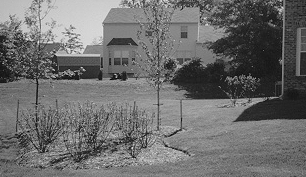
Rain Gardens can be an attractive and marketable amenity to a site
Comments (Coffman 1997)
Overall acceptance of the Rain Gardens by Sommerset residents has been excellent. Homeowners are actively maintaining the Rain Gardens and have registered very few complaints. Only one of the gardens has had functional problems, which are believed to have been caused by too much water being diverted to it for treatment. There have been no concerns or problems with safety or mosquitoes.
Contacts and References
- Larry Coffman. Department of Environmental Resources. Prince George's County, MD. .
- Curry, W.K. and S.E. Wynkoop, eds. 1995. "How does your Garden Grow?": A Reference Guide to Enhancing Your Rain Garden. Landover, MD: Prince George's County Department of Environmental Resources.
- Daniels, L. 1995. Maryland developer grows "Rain Gardens" to control residential runoff. Nonpoint Source News-Notes 42 (August/September): 5-7.
Bioretention
Beltway Plaza Shopping Center
Vegetated islands in the parking lots were designed to serve as filters for stormwater. These parking lot biofilters were less expensive than traditional stormwater management and also partially fulfilled the landscaping requirements for the development.
[The developers] obviously saved a substantial amount of money.
- Derek Winogradoff, Prince George's County Department of Environmental Resources (1998)
Introduction to Beltway Plaza Shopping Center
- Commercial shopping mall located in Greenbelt, Maryland.
- An existing shopping center was converted into an indoor mall. Additional stormwater management facilities were required as part of the conversion and expansion.
Feature BMP: Parking Lot Biofilters (Winogradoff 1998)
- The parking lot is designed so that all runoff is channeled into these landscaped islands located throughout it.
- Designed to promote rapid infiltration of water, which allows them to handle large volumes of stormwater.
- Stormwater infiltrates through approximately 3 feet of coarse-textured soil and is then collected in perforated pipes and transported to the county's storm drain system.

Parking lot biofilter with inline overflow drain
Economic and Marketing Benefits (Winogradoff 1998)
- Derek Winogradoff of Prince George's County Department of Environmental Resources estimated that the developer saved a substantial amount of money by choosing the biofilters over traditional stormwater management methods, because economic reasons were what drove the developer's decision to use the biofilters.
- Fulfilled the development's stormwater management requirements as well as satisfied a significant portion of its landscape requirements.
- Featured in several slide shows on stormwater management.
Maintenance
- Maintenance costs are approximately the same as that for conventional stormwater management, as reported by the property managers for the development (Winogradoff 1998).
- Maintenance procedures for the facilities are comparable to those for traditional commercial landscaping (e.g. pruning vegetation, weeding and replacing dead plants).

Curb cut inlets and plantings in parking lot biofilter
Contacts and References
- Derek Winogradoff. Department of Environmental Resources. Prince George's County, MD. .
Wet Ponds
Wet Ponds are constructed stormwater ponds that contain permanent pools of water. Their construction costs are comparable to traditional dry ponds, yet they provide many amenities such as recreation, wildlife habitat and increased property values.
Experience has shown wet ponds to be less costly to maintain than dry ponds, more effective in reducing sediment, and more appealing for recreational and aesthetic purposes.
- National Association of Home Builders Land Development Magazine (Hilsenwrath and Zachary 1996)
Introduction
- Also known as retention ponds. Composed of an inlet, a sediment forebay, a permanent pool, an aquatic bench and an outlet structure.
- Must be designed carefully so as to enhance the surrounding landscape and to adequately treat stormwater from its watershed.
- As a general rule, "bigger is better" from an economic and environmental perspective (Schueler 1987).
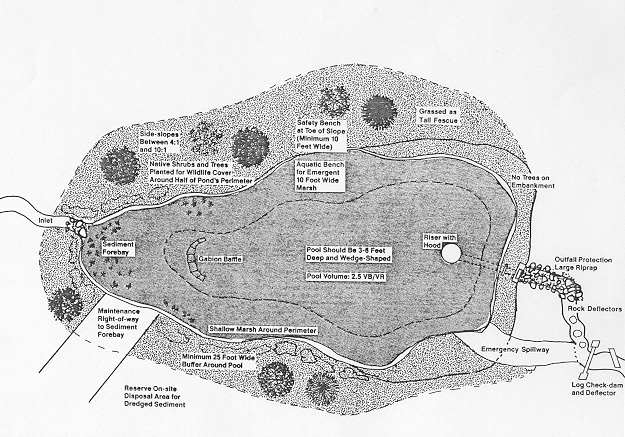
Schematic of wet pond (Schueler 1987)
Applications and Restrictions (Schueler 1987)
- Most effective in residential or commercial sites greater than 20 acres with a dependable source of water.
- Require significant amounts of land (usually between 2% and 5% of total development size), therefore, they are not suitable for areas where land is at a premium.
Active Pollutant Removal Processes
Effectiveness of pollutant removal is a function of the amount and type of incoming pollutants and the size and design of the permanent pool. The size of the permanent pool in relation to the pond's watershed is the most important factor effecting its pollutant removal. Pollutant removal mechanisms include sedimentation, biological uptake, infiltration and microbial action.
Estimated Pollutant Removal of Wet Ponds in N. Carolina Piedmont
| Pond Characteristic |
Lakeside Pond |
Runaway Bay |
| Drainage area (acres) |
65
|
437
|
| Imperviousness (%) |
46
|
38
|
| Pond area (acres) |
4.9
|
3.3
|
| Mean Depth (ft.) |
7.9
|
3.8
|
| Equivalent watershed storage (in.) |
7.1
|
0.33
|
| Water Quality Parameter |
Removal Rate (%)
|
| Total Suspended Solids |
93
|
62
|
| Total Phosphorus |
45
|
36
|
| Total Kjeldahl Nitrogen |
32
|
21
|
| Pond Area/Watershed Area |
7.5
|
2.3
|
Note the differences in the characteristics of the two ponds and how it affects their ability to cleanse stormwater.
(Schueler 1995b)
Economic and Marketing Benefits
- Increases property values because of aesthetic benefits.
- Offers high community acceptance and landscaping amenities.
Construction (Brown and Schueler 1997a)
- Construction cost for a wet pond of less than 100,000 cubic feet can be estimated using the following equation:
TC = (23.07)(Vs0.705) r2=0.80
where: TC = total cost in 1997 U.S. dollars
Vs = volume of storage of the pond
Maintenance (Schueler 1987)
- Inspect annually to insure proper functioning of the pond system.
- Mow the grassy area surrounding the wet pond (side-slopes, emergency spillway and embankment) at least twice a year to prevent growth of woody vegetation. More frequent mowing may be desirable for recreational and aesthetic purposes.
- Control the weeds, algae and insects if they become a problem.
- Remove debris and litter.
- Complete non-routine maintenance including structural replacement and repairs (every 25-75 years) and removal of accumulated sediment (every 10-20 years).
- Annual maintenance costs for routine and non-routine maintenance generally range between 3% and 5% of the base construction cost.
Environmental Benefits
- Extends the detention times so pollutant removal processes can work.
- Vegetative uptake of pollutants.
- Controls peak discharge.
Additional Benefits
- Creates wildlife habitat.
- Contributes an aesthetic "park-like" setting in which to live and work
- Provides recreation opportunities (e.g. fishing, boating, etc.)
Tips for Maximizing Your Pond Premium (Schueler 1995b)
- Make the pond as large as possible.
- Add items such as a walking trail, picnic tables and a gazebo.
- Properly maintain the pond to prevent unsightly vegetation and nuisances such as algae.
- Construct your pond with safety in mind (e.g. avoid steep slopes, use an aquatic bench).
- Design and landscape your pond so that it enhances the surrounding environment.
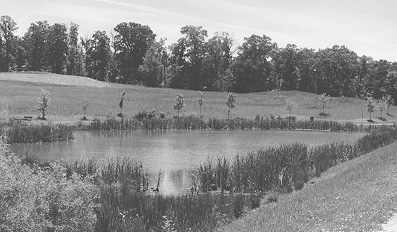
Vegetated benches provide water quality/habitat enhancement
and help make this pond an aesthetic amenity
Contacts and References
- Brown, W. and T.R. Schueler. 1997. The Economics of Stormwater BMPs in the Mid-Atlantic Region. A report prepared for the Chesapeake Research Consortium, Inc. Ellicott City, MD: Center for Watershed Protection.
- Frederick, R., R. Goo, M.B. Corrigan, S. Bartlow, and M. Billingsley. Tetra Tech, Inc. 1995. Economic benefits of runoff controls. Nonpoint Source Pollution Control Program. A report prepared for U.S. Environmental Protection Agency, Office of Water. <http://www.epa.gov/OWOW/NPS/runoff.html> (21 May 1997).
- Schueler, T.R. 1987. Controlling Urban Runoff: A Practical Manual for Planning and Designing Urban BMPs. A report prepared for Washington Metropolitan Water Resources Planning Board. Washington, DC: Metropolitan Washington Council of Governments.
- Schueler, T.R. 1995. The pond premium. Watershed Protection Techniques 2 (1) (Fall): 303.
Wet Ponds
Laurel Lakes Executive Park
This mixed-use development is centered around two attractive stormwater BMP ponds. Having the ponds as the development's focal point has allowed the developer to introduce a higher priced product into a depressed market, to realize an above average sales pace and to receive a substantial premium on lakefront units.
Having the development situated around the two beautiful lakes has allowed us to do three things: (1) "to introduce a higher priced product which made us more money", (2) "to move product when everyone else was having trouble selling" and (3) "to take a difficult site and make it work.
- Bob Kaufman, Developer, Michael T. Rose Development Co., Inc. (1997)
Introduction to Laurel Lakes
- Mixed commercial and residential property in Laurel, Maryland.
- Parts of the development are centered around two large wet ponds.
- Lakefront property includes townhouses, ranging from $115,000 to $150,000, and first-class office space.
Feature BMP: Wet Pond
- Lake in the commercial section is surrounded by walking and jogging trails, picnic tables, restaurants and a nice lawn. People like to be in that office park because of the lake (Kaufman 1997b).

View of the lake taken from the front door of an office condominium
Economic and Marketing Benefits
This is one of the most successful developments we've ever done (Kaufman 1997b).
- Depending on layout and size, office space fronting the lake rents for a premium of $100 to $200 per month, relative to non-lakefront units (Frederick et al. 1995).
- On average, first-class waterfront office space in Prince George's County, Maryland rents for a premium of between $1.00 and $3.50 per square foot (Frederick et al. 1995).
- Offers a unique environment in an otherwise ordinary area that makes the development easier to market (Kaufman 1997a).
- Allowed the developer to maximize the land by putting in "back-to-back" townhouses and office condos. The units fronting the lake did not have front door parking and normally would have sold for a reduced price, however, because they front the lake, they received the same price.
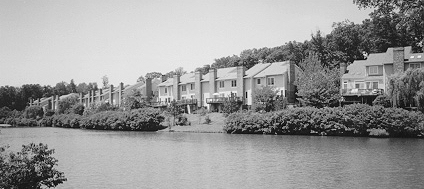
View of the second lake with adjacent townhouses
Note near-water vegetation that provides runoff filtering and cover for fish
Construction
- Constructed by damming an existing creek.
- Now used as the development's stormwater BMPs.
Maintenance
- The lakes and surrounding facilities (e.g. clubhouse, walking trails) were donated to the City of Laurel who is now responsible for their maintenance (Kaufman 1997a).
Contacts and References
- Bob Kaufman. National Vice President, Michael T. Rose Development Co., Inc. Laurel, MD. .
Wet Ponds
Chancery on the Lake
Condominium development centered around a 14-acre wet pond. The lake is marketed as the development's feature and this strategy has resulted in an increased sales pace relative to that of competitors. Furthermore, a premium of $7,$10,000 is realized on lakefront units.
[The lake] has definitely increased our sales pace over that of our competitors. Every month we get some of our competitors sales, and I'm certain that it's primarily due to the lake.
- Debora Flora, Sales Manager, Chancery Associates (1997)
Introduction to Chancery on the Lake
- 7-acre, unit condominium development in Alexandria, Virginia centered around a large urban runoff pond.
- Prices for the condominiums range from $129,990 to $139,990 (Frederick et al. 1995).
Feature BMP: Wet Pond
- 14-acre pond surrounded by picnic tables, a gazebo and a walking trail. A fishing pier will also be built (Frederick et al. 1995).
Economic and Marketing Benefits
- $7,000 to $10,000 premium for condos that front the lake (Flora 1997).
- Above average sales pace for the area and the condominium market. A significant number of their sales come from buyers who have shopped around and have settled on Chancery because of the attractive lake (Flora 1997).
- Marketed as the feature selling point of the development (Flora 1997).

View of the rear of the condominiums
Construction (Scanlon 1997)
- Constructed by damming an existing creek. Some excavation of the surrounding area was also performed to achieve the desired shape and volume.
Maintenance
- No maintenance has been required other than mowing of grassed areas, visual inspections of the dam and lake and sediment removal from the rip-rap outfall structure (Scalia 1997).

View of the walkway, picnic area and lake
Additional Benefits
- Serves as a buffer zone between the development and the adjacent 4-lane road.
Contacts and References
- Debora Flora. Sales Manager, Chancery Associates Limited Partnership. Alexandria, VA. .
- Vic Scalia. Halle Enterprises. Silver Spring, MD. .
Filtration/Infiltration
Filtration involves the transfer of water through a porous medium before it is returned by pipe to either a stream or stormwater drain. Infiltration facilities temporarily impound stormwater and discharge it via percolation into the surrounding soil (VADCR 1999). The soil aids in the removal of pollutants from the water before it is released to the groundwater. They are appealing since they help reverse the consequences of urban development by reducing peak flows and recharging ground water supplies.
Introduction
Filtration techniques
Infiltration techniques
Applications and Restrictions (VADCR 1999)
Filtration
- Suitable where the water table is sufficiently lower than the design depth of the facility.
- Attractive for medium to higher density projects because of its high removal efficiency.
- Not recommended where sediment loadings are high and may cause clogging of the filtration device.
Infiltration
- Suitable where the subsoil is permeable enough to provide a reasonable rate of infiltration.
- Should be used to control the water quality volume up to the 2-year design storm. Not effective for large volumes of runoff.
- Underlying topography should not be karst in nature and the water table should be sufficiently lower than the facility to prevent groundwater contamination.
- Adapted for low to medium density development with 38-66% impervious cover.
- Provide no wastewater quantity control. This must be provided by a separate facility.
- Infiltration BMPs should be constructed after stabilization to avoid clogging.
Active Pollutant Removal Processes
Estimated Pollutant Removal of Filtration/Infiltration
| |
|
Filtration
|
Infiltration
|
| |
Water Quality Parameter |
Removal Rate (%)
|
| |
Total Suspended Solids |
81
|
88.5
|
| |
Total Phosphorus |
45
|
65
|
| |
Total Nitrogen |
32
|
82.5
|
| |
Organic Carbon |
57
|
82
|
| |
Lead |
71
|
98
|
| |
Zinc |
69
|
99
|
(Brown and Schueler 1997b)
Contacts and References
- Brown, W. and T.R. Schueler. 1997. National Pollutant Removal Performance Database for Stormwater BMPs. A report prepared for the Chesapeake Research Consortium. Ellicott City, MD: Center for Watershed Protection.
- Virginia Department of Conservation and Recreation. 1999. Virginia Stormwater Management Handbook. Richmond, VA: Division of Soil and Water Conservation.
Sand Filters
Sand filters are a type of BMP which use a bed of sand to filter pollutants out of stormwater runoff. The District of Columbia sand filters are placed underground which is an economic benefit, because they utilize zero buildable land and pose no safety hazard to the public. Austin sand filters, or surface sand filters, operate in basically the same way as the underground filters.
Introduction
- Utilize sand as a filtering media to strain pollutants out of stormwater runoff.
- Designed to treat only water quality volume (WQV). Flows in excess of the WQV are diverted away from the filter to a downstream stormwater management facility.
- Four basic design components: (Claytor and Schueler 1996)
- 1. inflow regulator which directs the preferred WQV into the sand filter
- 2. pretreatment structure to extract coarse sediments to prevent clogging of the filter
- 3. filter bed and filter media (usually 18 inches to four feet deep)
- 4. outflow mechanism to return treated water back to conveyance system or which allows the treated water to infiltrate the soil
- This chapter will discuss and profile the underground sand filter, however, the general ideas may be applied to all sand filters.
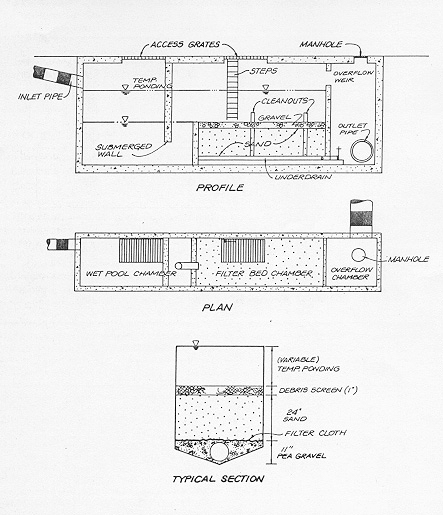
Schematic of underground sand filter (Claytor and Schueler 1996)
Applications and Restrictions
- Most feasible for development sites less than 5 acres. Not typically cost effective for larger drainage areas (Claytor and Schueler 1996).
- Adapted for sites where space is limited or land is prohibitively expensive for use of traditional BMPs.
- Should be designed to treat runoff from impervious surfaces only (helps prevent clogging).
- Provide no wastewater quantity control. This must be provided by a separate facility.
- Most applicable for industrial and residential sites.
- Provide no aesthetic, wildlife or recreational benefits.
Active Pollutant Removal Processes
The underground sand filter utilizes many components to cleanse stormwater. The wet pool chamber provides the opportunity for sedimentation to occur. The sand filter media provides for filtration, infiltration (if the treated water is not piped out) and adsorption. Microbial reactions will also occur as the sand becomes colonized by microbes.
Estimated Pollutant Removal of a Perimeter Sand Filter in Alexandria, VA
| |
Water Quality Parameter
|
Removal Rate (%) a
|
| |
Total Suspended Solids |
79
|
| |
Petroleum |
ND
|
| |
BOD (5 day) |
78
|
| |
Total Phosphorus |
63 b
|
| |
Total Nitrogen |
47
|
| |
Zinc |
91
|
a. fraction of total incoming pollutant load retained in filter over all storms
b. removal rates were higher if four anaerobic events are excluded
ND parameter not detected in runoff during sampling study
Note: Number of storms = 20
(Claytor and Schueler 1996; Bell, Stokes, Gavan and Nguyen 1996)
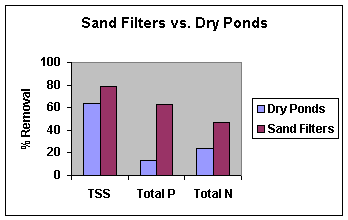
Economic and Marketing Benefits
- Use little or no buildable land.
- Pose no threat to the public, therefore fewer liability concerns and costs than with a dry pond.
Construction
- Costs between $25,000 and $30,000 per impervious acre when the concrete shells are cast on site (Bell 1997).
- Concrete shells are now being precast which should decrease costs by at least 20% (Bell 1997).
Maintenance
- Inspect semi-annually to insure proper functioning of the filter. Inspections are also recommended after major storms (Claytor and Schueler 1996).
- Perform corrective maintenance when drawdown times exceed specified lengths (Claytor and Schueler 1996).
- Replace filter cloths every 3-5 years (Bell 1997).
- If regular maintenance is performed, major repairs and maintenance will not be required (Bell 1997).
Environmental Benefits
- Reliably and effectively treat stormwater quality.
- No environmental drawbacks such as groundwater contamination (if designed with underdrains), stream warming or wetland impairment (Claytor and Schueler 1996).
Additional Benefits
- Invisibility of the BMP.
- No potential for mosquito problems.
Contacts and References
- Anacostia Restoration Team. T.R. Schueler, P.A. Kumble, and M.A. Heraty. 1992. A Current Assessment of Urban Best Management Practices. A report prepared for USEPA Office of Wetlands, Oceans, and Watersheds. Washington, DC: Metropolitan Washington Council of Governments.
- Claytor, R.A. and T.R. Schueler. 1996. Design of Stormwater Filtering Systems. report prepared for Chesapeake Research Consortium, Inc. December. Ellicott City, MD: Center for Watershed Protection.
Sand Filters
Duke Street Square
At this ultra-urban site, an effective BMP was required, however, buildable land was very limited. An underground sand filter was installed, which satisfied stormwater regulations, and, because it consumes zero buildable land, the developers were able to add 5 to 7 townhomes which would have been lost to land requirements of a BMP pond.
The sand filter is out of the way, out of sight, and requires very little maintenance, while a dry pond has to be maintained all the time, is an eyesore, and kids like to play in them so they're a safety hazard too.
- Glenn Teets, Project Manager, Wills Land Development Company (1997)
Introduction to Duke St. Square
- 40-unit townhouse development located in Alexandria, VA.
Feature BMP: Underground Dry Vault Sand Filter
- Off-line sand filter system services 1.38 impervious acres.
- Parking lot is designed with grate inlets connected to underground pipes which carry stormwater to the sand filter. Flows in excess of the first 0.5 inches of rainfall are diverted to the city's stormsewer system.
- The filter's concrete chamber was cast in place (Keller 1997).
- Designed with underdrains that transport filtered water to the city stormsewer system (Keller 1997).
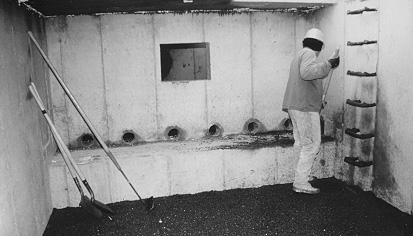
View of the inside of a sand filter similar to the one installed at Duke St. Square
Economic and Marketing Benefits
- Uses zero buildable land. Northern Virginia real estate prices of approximately $40 per square foot make it very expensive to install dry ponds, wet ponds or stormwater wetlands (Bell 1997).
- Added 5 to 7 townhouse units which normally would have been lost to the land requirements of a dry pond (Teets 1997).
Construction
- Total construction cost for the sand filters was $41,030. This includes the dry vault sand filter, two monitoring manholes and pipes with connections. The sand filter itself cost $35,197.
- The entire system cost $29,732 per impervious acre, while the sand filter alone cost $25,505 per impervious acre.
Maintenance (Keller 1997)
- Replace filter's sand bed approximately every 5 years.
- Inspect periodically and remove accumulated trash from grate inlets, pretreatment structure and filter bed.
- The home-owners association has set aside a specified annual amount of money for routine and non-routine maintenance.
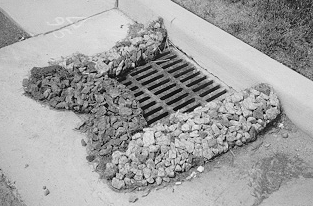
View of an inlet grate at Duke St. Square
Contacts and References
- Warren Bell. City Engineer, City of Alexandria. Alexandria, VA. .
- R.J. Keller, L.S. Project Manager, R.C. Fields Jr. and Associates, P.C. Alexandria, VA. .
- Glenn Teets. Project Manager, Wills Company. Vienna, VA. .
Infiltration Chambers
Infiltration chambers are interlocking, arched chambers that are open at the bottom, allowing the stormwater to infiltrate the subsurface where microorganisms and the soil help remove pollutants and sediment. They use little to no buildable land.
CULTEC chambers effectively serve environmentally sensitive areas while making valuable land available for parking lots, athletic fields and other applications.
- CULTEC Environmental Technologies sales brochure (1999)
Introduction
- Extend the time the water spends in the soil thus allowing for enhanced removal of pollutants.
- Constructed of heavy-duty polyethylene.

Schematic of infiltration chambers (Fisher 1998)
Applications and Restrictions
- Can be placed under most developed surfaces. Available in a heavier gauge for use under trafficked areas.
- Adapted for sites where space is limited or land is prohibitively expensive for use of traditional BMPs.
- Most applicable for industrial, highly urbanized sites.
- Provide no aesthetic, wildlife or recreational benefits.
Active Pollutant Removal Processes
The microorganisms that develop along the soil take in many of the phosphates, nitrates and other pollutants. The soil filters the stormwater and captures much of the sediment and remaining pollutants.
There is no data on the pollutant removal efficiency of the chambers, however it is assumed to be equal to or greater than that of other infiltration practices. Evaluation of the system began in 1999 by the Environmental Technology Evaluation Center using criteria developed by a panel of stormwater and septic wastewater management experts.
Estimated Pollutant Removal of Infiltration
| |
Water Quality Parameter
|
Removal Rate (%)
|
| |
Total Suspended Solids |
88.5
|
| |
Total Phosphorus |
65
|
| |
Total Nitrogen |
82.5
|
| |
Organic Carbon |
82
|
| |
Lead |
98
|
| |
Zinc |
99
|
(Brown and Schueler 1997b)
Economic and Marketing Benefits (CULTEC 1999)
- Polyethylene is cheaper than using concrete pipe.
- Less area and less crushed stone is required with the chambers than with traditional stormwater management systems.
- Much greater lengths of the chambers can be delivered per truckload than of HDPE pipe (1700 ft. compared to 360 ft.)
Construction
- Excavation of the site is required and the fill soil must be sandy to promote infiltration.
- A detailed cost analysis computed $4 per cubic foot including materials, labor, chambers, excavation and fill material (Maestro 1999c).
- The polyethylene chambers interlock so they don't have to be screwed together [which] saves a great deal of labor (Taggart 1999).
Maintenance
- Remove blockages from the intake. Maintenance is minimal.
Environmental Benefits
- Very reliable and effective in the treatment of stormwater quality.
Additional Benefits
- Fifty percent more storage capacity and 1000 times greater drainage potential than conventional piping (CULTEC 1999).
- Contribute to water quantity volume by reducing the peak flow which minimizes scouring in the destination stormwater pond.
- No threat to public safety or potential for mosquito problems.
- Invisible and uses little or no buildable land.
Contacts and References
- Bob Maestro. Environmental consultant, CULTEC Environmental Technologies. .
Infiltration Chambers
Capital One
Case Study Under Construction
Data Gathering in Progress
Additional stormwater management was made necessary on this site due to the additional parking requirements. The site had a preexisting wet pond and did not have the space to expand the pond or use other space-intensive alternatives. Therefore the developer opted for one of the techniques suitable for ultra-urban sites, infiltration chambers.
Introduction to Capital One
- Addition of parking lot required treatment of a greater water quality volume.
- The site is currently served by an unattractive wet pond.
Feature BMP: Infiltration Chambers
- Infiltration chambers serve .65 acres of impervious area.
- The parking lot is designed with a drop inlet at the lowest point to divert the water into the chambers.
- The stormwater is directed into the chambers until the storage capacity is reached. The overflow is then sent to the existing stormdrain emptying into the wet pond.
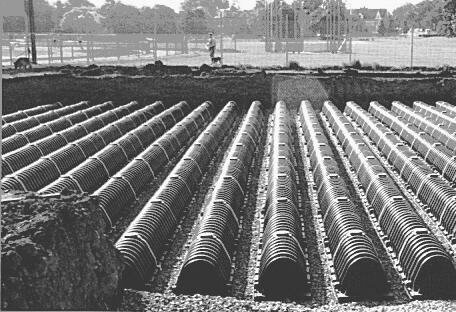
CULTEC Recharger infiltration chambers (CULTEC 1999)
Economic and Marketing Benefits
- Though more expensive than traditional dry sediment basins, the chambers produce cost savings by conserving space that is then available for other uses. This is especially useful in areas with high real estate prices.
- Poses no threat to the public, therefore fewer liability concerns and costs than with a dry pond.
Construction
- Total construction costs for the infiltration chambers was ?.
- The design unit capacity is 10.4 cubic feet per linear foot. The total capacity of the chambers at this site is 770 cubic feet.
Maintenance
Environmental Benefits
Additional Benefits
Contacts and References
- Bob Maestro. Environmental consultant, CULTEC Environmental Technologies. Occoquan, VA. .
- Doug Tait. General contractor, W.C. Spratt. Fredericksburg, VA. .
- Kim Fisher. Project Manager, McKinney & Co. Ashland, VA. .
Infiltration Chambers
Belmont Bay
Case Study Under Construction
Data Gathering in Progress
Infiltration chambers are used along Dawson Beach Road to pretreat the stormwater from the adjacent industrial site before it is delivered to the stormwater pond. Dust from the concrete plant causes the runoff water to be too polluted to be discharged directly into the irrigation pond. Chambers will also be used in the planned town center to treat runoff before it enters the Occoquan River.
[The infiltration chambers cost] about $2000, at least 40 to 60% cheaper than using concrete pipe, which would have only moved the water.
- Dennis Shiflett, Woodbridge Institute for Sustainability (Taggart 1998)
Introduction to Belmont Bay
Feature BMP: Infiltration Chambers
- Culvert transporting stormwater from adjacent industries to the golf course BMP wet pond.
Interlocking infiltration chambers used to transport stormwater from adjacent
industrial site to golf course wet pond (Taggart 1998)
Economic and Marketing Benefits
- Cost 40-60% less than concrete pipe (Taggart 1998).
Construction
- Total construction costs for the chamber system was $2000 (Taggart 1998).
Maintenance
Environmental Benefits
Additional Benefits
Contacts and References
- Bob Maestro. Environmental consultant, CULTEC Environmental Technologies. Occoquan, VA. .
Stormwater Wetlands
Stormwater wetlands are constructed wetland systems that use natural processes to control stormwater quantity and quality. Their construction costs are comparable to that for traditional BMP ponds yet they provide many amenities such as wildlife habitat, aesthetic value, recreation and education opportunities. They also have excellent longevity and reliability.
[Stormwater wetlands] provide scenic views and wildlife habitat that enhance the community surrounding the wetlands.
- National Association of Home Builders Land Development Magazine (Hilsenwrath and Zachary 1996)
Introduction
1. shallow marsh
2. pond/wetland system
3. extended detention wetland
4. pocket wetland

Schematic of pond/wetland system (Schueler 1992)
Applications and Restrictions
- Can be adapted to a wide variety of sites.
- Require minimum drainage areas of 25 acres (Schueler 1992).
- Not advisable for heavily industrialized sites or areas subject to inputs of road salts and deicing compounds (Schueler 1992).
- Require more land than most other urban BMPs.
Active Pollutant Removal Processes
Stormwater wetlands are designed to mimic the pollutant removal processes present in natural wetlands. They provide increased surface area and extended contact time for pollutant interaction with soil and plant material. These two factors allow for enhanced pollutant removal via sedimentation, filtration, infiltration, microbial reactions, plant uptake and adsorption.
Estimated Pollutant Removal of Stormwater Wetlands
| |
Water Quality Parameter
|
Removal Rate (%)
|
| |
Total Suspended Solids |
75
|
| |
Total Phosphorus |
65
|
| |
Total Nitrogen |
40
|
| |
Organic Carbon |
15
|
| |
Bacteria |
2 log reduction
|
| |
Lead |
75
|
| |
Zinc |
50
|
Note: The removal rates are for the pond/wetland system.
(Schueler 1992)
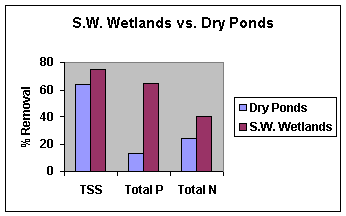
Construction (Brown and Schueler 1997a)
- Total cost of construction for wetland systems is estimated using the same formula as that for wet ponds.
- Construction cost for a wet pond of less than 100,000 cubic feet can be estimated using the following equation:
TC = (23.07)(Vs0.705) r2=0.80
where: TC = total cost in 1997 U.S. dollars
Vs = volume of storage of the pond
Maintenance (Schueler 1992)
- Inspect twice a year for the first three years and on an annual basis thereafter. Analyze items such as species survival, sediment accumulation, hydrology, berms and outfalls during these inspections.
- Clean out sediment forebay every 3 to 5 years.
- Mow surrounding grassed areas on a regular basis to prevent woody growth.
- Maintain to prevent algal growth, noxious odors and mosquito infestation.
Additional Benefits
- Excellent potential for wildlife habitat.
- Expected longevity of 20+ years (Schueler 1992).
- Aesthetically pleasing.
- Less hazardous than the open water of a wet pond.
Tips for Enhancing the Pollutant Removal of Stormwater Wetlands (Schueler 1992)
- Increase the volume of runoff to be treated (Schueler 1992).
- Increase the surface area to volume ratio (Schueler 1992).
- Use a sediment forebay for pre-treatment and to distribute the flow throughout the wetland (Schueler 1992).
- Increase the effective distance from inlet to outlet by creating a meandering flowpath (Schueler 1992).
- Install a submerged gravel filter at the outlet to help foster denitrification (Claytor and Schueler 1996).
Contacts and References
- Anacostia Restoration Team. T.R. Schueler, P.A. Kumble, and M.A. Heraty. 1992. A Current Assessment of Urban Best Management Practices. A report prepared for USEPA Office of Wetlands, Oceans, and Watersheds. Washington, DC: Metropolitan Washington Council of Governments.
- Schueler, T.R. 1992. Design of Stormwater Wetland Systems: Guidelines for Creating Diverse and Effective Stormwater Wetland Systems in the Mid-Atlantic Region. A report prepared for Nonpoint Source Subcommittee of the Regional Water Committee. October. Washington, DC: Metropolitan Washington Council of Governments.
Stormwater Wetlands
Fredericksburg Christian School
A two stage pond/created wetland system used to cleanse runoff and serve as an outdoor classroom and community demonstration project.
Introduction to Fredericksburg Christian School (Foss 1997)
- Private school servicing students from pre-kindergarten through 12th grade.
- Four campuses located in the Fredericksburg area. The newest campus is a high school facility being constructed on 20 acres of a 75-acre site in Spotsylvania County.
Feature BMP: Two Stage Stormwater Pond/Wetland System (Tippett 1997)
- First stage: wet pond designed to hold runoff from the site and function in primary treatment. This pond will provide extended detention for settling so as not to overload the wetland with sediment.
- Second stage: wetland system constructed to retain and infiltrate overflow from the pond. The natural processes in the wetland system will provide very high pollutant removal rates.
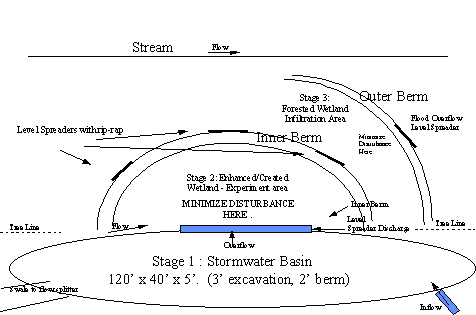
Conceptual design of FCS Stormwater Wetland/Pond
Economic and Marketing Benefits (Foss 1997)
- Serves as an outdoor classroom for the Fredericksburg Christian School students and the community.
- Provides a demonstration stormwater BMP project for the development community, which will enhance the school's reputation in the area.
- Helped the local Soil and Water Conservation District and citizen groups secure grant funding to cover design and building costs because of the innovative nature of project.
- Media coverage of the project helped with school marketing.
Construction (Tippett 1997)
- Low impact berms were used in an existing forested area to create the impoundment for the wetland system.
- Estimated cost was $2,000 for earth moving and rip-rap.
Maintenance
- Remove sediment from the pond (every 25-50 years).
Environmental Benefits (Tippett 1997)
- Provides extremely high levels of pollutant removal by two-stage treatment.
Additional Benefits
- Use pond area as an irrigation source (Tippett 1997).
Contacts and References
- Dr. Gary Foss. Superindentent, Fredericksburg Christian School. Fredericksburg, VA. .
- John Tippett. Executive Director, Friends of the Rappahannock. Fredericksburg, VA. .
Low Impact Ponds
Low impact ponds present an alternative method of constructing a BMP pond. With this method, the natural terrain and vegetation is left intact, and a natural ravine is dammed to form a dry detention pond. This results in significant cost savings because no land has to be cleared and excavated. Furthermore, a normally unsightly BMP pond is hidden from view.
Introduction
- Similar to a standard dry pond except that the land is not cleared, and an alternative dam structure is used to replace an earthen berm.
- Native vegetation is left in place and utilized in the pollutant removal process.
- Natural topography is used as the banks of the pond.
Applications and Restrictions
- Applicable to all types and sizes of developments.
- Must have suitable topography to allow for "low-impact" construction.
- Forested environments are the most suitable, because they allow for maximum concealment of the BMP pond.
- Damming of streams is a regulated activity. Streams capable of supporting migratory fish populations are not appropriate for this BMP.
Active Pollutant Removal Processes
Low impact dry ponds use natural ecosystems to control stormwater quantity and quality. They provide increased surface area and extended contact time for pollutant interaction with soil and plant material. These two factors allow for enhanced pollutant removal via sedimentation, infiltration, microbial reactions, plant uptake and adsorption. The estimated pollutant removal of low impact ponds is assumed to be similar to that for standard extended detention dry ponds.
Economic and Marketing Benefits
- Minimal amount of clearing, grading and excavating.
- Reduced maintenance costs since it does not require mowing.
- Decreased liability concerns (Pickett 1997a).
- Same facility provides for short-term erosion and sediment control as well as long-term stormwater management. This reduces the need for silt fences, hay bales, etc. (Pickett 1997a).
- Reduced risk of failure. The timber dam is much more stable than earthen berms which are subject to wash-outs (Pickett 1997a).
Construction
- Costs will vary widely between projects depending on topography, type of dam used, etc.
- Construction costs will generally be much less than for conventional dry ponds.
Maintenance (Harper 1997)
- Removal of accumulated sediment from the sediment forebay (every 5-10 years).
- Semi-annual inspection and replacement of dam structure when required (estimated longevity of 25-30 years for treated timber dam) (Pickett 1997a).
- Periodic inspection to insure proper performance.
Environmental Benefits
- Very little land disturbance during the construction and installation of the BMP.
- Recharge of groundwater supplies.
- Use of mature, native vegetation in the pollutant removal process.
Additional Benefits
- Unattractive BMP hidden from view.
- Pond and timber structure is ready for operation as soon as installation is complete.
Low Impact Ponds
VDOT Facility- Lottsburg, VA
An innovative dry pond was installed at this site to account for its unique surroundings. A natural ravine was dammed with a timber structure to form the basin of the dry pond. This resulted in a considerable cost savings (at least $23,500), plus a normally unsightly and hazardous BMP pond was hidden from view.
The main benefit was from a construction management standpoint. We had to disturb very little land to construct [the BMP], and it was a fail-safe safety valve for our erosion and sediment control. Plus, all the other little benefits like the cost savings and reduced maintenance add up to make it a great project.
- Bob Pickett, District Environmental Manager, Virginia Department of Transportation (1997a)
Introduction to VDOT Facility
- Area headquarters facility for the Virginia Department of Transportation (VDOT) in Northumberland County, Virginia.The BMP was installed to account for facility expansion.
Feature BMP: Low Impact Dry Pond
- The site was left in its natural state and a timber structure was used to dam the dry pond instead of the standard earthen berm. The timber dam is 70 feet long, 8 feet tall and extends 3 feet into the bank on each side. The pond services 10.1 acres of improved surfaces.
- Utilized the natural terrain as the banks of the dry pond to prevent the mass clearing and excavation normally associated with a BMP pond.
- A small rip-rap structure was installed to act as a dam for the sediment forebay, which is the only visible part of the pond. This was installed at the head of the pond in a cleared area so that it would be accessible for clean outs.
Construction
- Total construction costs (materials and labor) for the project were $11,453 (Pickett 1997b).
- Realized a cost savings of at least $23,500, since the projected costs for installing a standard dry pond (with an earthen basin) at this site were $35,000 to $40,000 (Harper 1997).
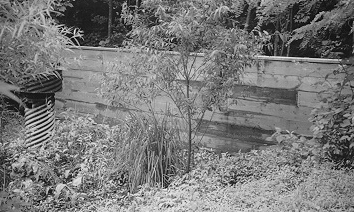
View of the pond basin, riser and timber dam
Environmental Benefits
- BMP was built first and was in place before VDOT began construction (Pickett 1997a), thereby controlling construction erosion and sedimentation.

View of the pond basin and riser from atop the dam
The minimal disturbance makes the facility almost
indistinguishable from the surrounding forest
Contacts and References
- Bob Pickett. Environmental Manager, Virginia Department of Transportation. Fredericksburg, VA. .
- Ken Harper, Department of Conservation and Recreation. Richmond, VA. .
Open Vegetated Channels
Vegetated drainage channels replace concrete channels and underground drainage systems. Vegetated systems are much less expensive to install and include many amenities such as enhanced pollutant removal, aesthetic improvements and groundwater recharge.
Introduction
- Vegetated channels used by engineers to convey stormwater runoff that can often be redesigned to promote infiltration and pollutant removal.
- Four types of open channels: drainage channel, grassed channel, dry swale and wet swale.
- Can be designed with underdrains to carry filtered water to a downstream facility or without underdrains to promote infiltration of treated water.
- Coupled with checkdams to provide for control of stormwater quantity and quality.
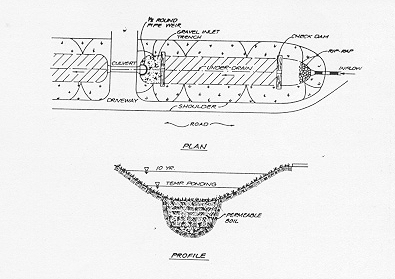
Schematic of engineered dry swale (Claytor and Schueler 1996)
Applications and Restrictions
- Most applicable for roadside drainage channels, however people tend to park in them which kills the vegetation and causes erosion problems.
- Must be an accepted development alternative as set forth by local ordinances.
- Best suited to residential developments but may also be used for commercial and industrial sites.
Active Pollutant Removal Processes
Open vegetated channels provide increased surface area and extended contact time for pollutant interaction with soil and plant material. These two factors allow for enhanced pollutant removal via filtration, infiltration, microbial reactions, plant uptake and adsorption.
Estimated Percent Removal of a Dry Swale
| |
Water Quality Parameter
|
Removal Rate (%)
|
| |
Total Suspended Solids |
90
|
|
Total Phosphorus |
65
|
| |
Total Nitrogen |
50
|
| |
Nitrate |
80
|
| |
Metals |
80-90
|
(Claytor and Schueler 1996)
Construction
- The use of vegetated channels generally results in significant cost savings because it eliminates the need for traditional curb-and-gutter systems, thus reducing the required amount of concrete.
- Also, vegetated channels replace concrete and/or rip-rap drainage channels which are extremely expensive.
- As sized for a typical residential development, curb-and-gutter costs from $14 to $20 per linear foot, while vegetated channels cost between $7 and $10 per linear foot (Lovett 1999).
Maintenance
- Mow grassed areas.
- Inspect periodically and repair to correct for erosion and channel scour.
Environmental Benefits
- Recharge groundwater supplies.
- Enhance pollutant removal.
- Help to maintain predevelopment hydrograph for all design storms.
Additional Benefits
- Aesthetically more pleasing than curb-and-gutter systems.
- Consume very little buildable land.
- Preserve rural character.
Contacts and References
- Claytor, R.A. and T.R. Schueler. 1996. Design of Stormwater Filtering Systems. A report prepared for Chesapeake Research Consortium, Inc. December. Ellicott City, MD: Center for Watershed Protection.
- Note: See Sommerset (1-6) and Northridge (9-5) case studies for information on the use of dry grassed swales.
Streambank Restoration/Bioengineering
Bioengineering is a method of halting property loss caused by eroding streambanks. It is accomplished by regrading the bank and planting with species that are resistant to erosion. This method is much less expensive than structural methods, such as armoring a streambank with rip-rap, and is aesthetically much more pleasing.
Introduction
- Designed to produce a forested ecosystem along the stream that will function in the same manner and provide the same benefits as a natural streamside ecosystem.
- Three basic approaches:
- hard- structural (e.g. rip-rap, concrete channelization, straightening channels)
- soft-vegetative
- bioengineering: combination of hard and soft approaches (Firehock and Doherty 1995)
- This chapter will address bioengineering techniques.
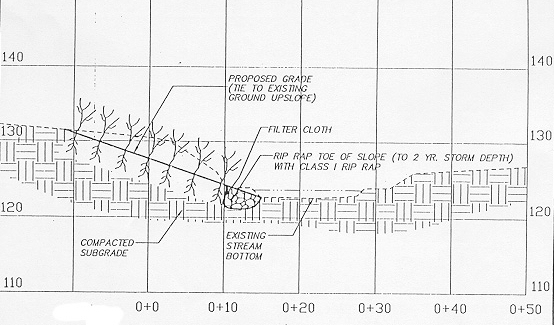
Example drawing for a bioengineering project (Wiggins 1997; Thomas 1997)
Applications and Restrictions
- Each streambank restoration project is site specific and should be tailored to meet the needs of your specific stream and watershed.
- Factors that should be considered in a restoration project:
- designated and desired uses of the stream (e.g. drinking water, recreation)
- land uses in the watershed
- streambank stability
- susceptibility to erosion
- velocity and flow of the stream
Active Pollutant Removal Processes
Streambank restoration projects are designed to produce mature forested buffer zones. If successful, the restored buffer zone will use natural ecosystems to control stormwater quantity and quality. They provide increased surface area and extended contact time for pollutant interaction with soil and plant material. These two factors allow for enhanced pollutant removal via filtration, infiltration, microbial reactions, plant uptake and adsorption. They also reduce thermal pollution by shading the stream. The estimated pollutant removal rates of streambanks which are successfully restored to a forested condition and are of adequate width should be similar to that of riparian buffers. (See Chapter 8 on riparian buffers for pollutant removal percentages.)
Economic and Marketing Benefits
- Increased property values due to aesthetic improvements of the streambank.
- Creates an opportunity for community involvement and a greener image of the developer and the development.
- Reduces erosion and halts property loss.
Construction
- Costs vary widely depending on the type of stabilization performed. Generally structural approaches are the most expensive followed by bioengineering and vegetative practices, respectively.
- Concrete channelization projects are very expensive and can cost up to $100,000 per linear foot while vegetative methods cost approximately $100 per linear foot (Firehock and Doherty 1995).
Maintenance (Wiggins 1997)
- Inspect on a regular basis for at least a year following completion to check for dead plants that may require replacement, gully formation, excessive weed growth and insect infestation.
- Take before, during and after pictures to monitor changes in the stream and its surroundings.
Environmental Benefits
- Restores pre-development streambank conditions (i.e. forested environment).
- Enhances pollutant removal.
- Shades the stream to prevent thermal pollution (i.e. low oxygen levels) of the stream and its receiving waters.
Additional Benefits
- Provides food, cover and habitat for wildlife
Comments
Streambank restoration projects provide an excellent opportunity to involve the public in a project to improve the environment. Much of the labor required can be performed by volunteers, which will reduce costs and aid in the marketing of a development. With a little effort and creativity, a stream bank restoration project can be turned into a community project. A good marketing idea is to hold a public meeting or cookout where people can express their views, be educated on the value of the stream and socialize amongst themselves and the development community.
Contacts and References
- Hal Wiggins. Environmental Scientist, U.S. Army Corps of Engineers. Spotsylvania, VA. .
- Firehock, K. and J. Doherty. 1995. A Citizen's Streambank Restoration Handbook. Gaithersburg, MD: Save Our Streams Program, Izaak Walton League of America, Inc.
- Laurent, S., ed. 1992. Engineering Field Handbook-Chapter 18: Soil Bioengineering for Upland Slope Protection and Erosion Reduction. October. Washington, DC: U.S. Department of Agriculture, Soil Conservation Service.
Streambank Restoration/Bioengineering
Massaponnax Creek at Lee's Hill
Severely eroded sections of Massaponnax Creek posed not only an environmental hazard but were also an eyesore to Lee's Hill and its golf course. The streambanks were revegetated and stabilized which enhanced the aesthetic appeal of the creek and saved the developer approximately $120,000 over what it would have cost to stabilize with rip-rap alone.
Had they done it with all rock [rip-rap], it would have been about three times as expensive.
- David Tice, Project Consultant, North American Resource Management Inc. (1997)
Introduction to Massaponnax Creek and Lee's Hill
- 1acre residential/golf course development near Southpoint in Spotsylvania County, VA.
- Massaponnax Creek, a tributary of Ruffin's Pond and the Rappahannock River, flows through the development and the golf course.
- As part of a mitigation plan prescribed by the Army Corps of Engineers, Lee's Hill Partnership was required to restore 1.28 acres of terrestrial streambank.
Feature BMP: Streambank Bioengineering (Tice 1997)
- Streambanks were first regraded (generally to a 3:1 slope) and class I rip-rap was placed at the toe of the slope to a 2-year storm depth.
- Live stakes, brush mattresses, fascines and brush layers were then used to stabilize eroded streambanks. The plantings were chosen to establish woody vegetation on the streambank.
- Some critical areas were covered to higher elevations with the rip-rap.
Economic and Marketing Benefits
- Realized cost savings of approximately $46,000.
Cost Comparison-Bioengineering vs. Rip-rap
| |
All rip-rap
|
Bioengineering and rip-rap
|
Cost Savings
|
| |
|
Rip-rap
|
Bioengineering
|
|
| Size (acres) |
1.28
|
.38
|
.90
|
|
| Cost per acre |
$82,900
|
$82,900
|
$31,700
|
|
| Cost for site |
$106,112
|
$31,502
|
$28,530
|
|
| Total Costs |
$106,112
|
$60,032
|
$46,080
|
Construction (Tice 1997)
- Total costs for the project were approximately $60,000, including labor, regrading of the streambank, bioengineering materials, rip-rap and consultant fees.
Maintenance
- Designed to not require any maintenance (Tice 1997). Nelson Cole, project manager for Lee's Hill Development Partnership, stated that the project has required no maintenance (1997).
- Required only when erosion occurs or vegetation dies.
Before After
Comments
David Tice states that additional cost savings could have been realized had less rip-rap been used on the project. The contractors and developers were overly cautious with the stone in some sections (i.e. used more stone than was required), and therefore made the project more expensive than necessary (1997).
Contacts and References
- David Hazel. Hazel Land Development Co., Inc. Fredericksburg, VA. .
- David A. Tice. David Tice and Associates, Ltd. Charlottesville, VA. .
- Hal Wiggins. Environmental Scientist, U.S. Army Corps of Engineers. Fredericksburg, VA. .
Streambank Restoration/Bioengineering
Massaponnax Creek at Southpoint
A severely eroding streambank was causing property valued at $10 per square foot to be lost to erosion (Elliot 1997). Through the use of bioengineering techniques, the erosion was halted, the aesthetics of the creek were improved and the developer realized a cost savings of at least $4,550 over the cost of doing the same project with rip-rap alone.
Doing it that way with natural vegetation was a huge cost savings and certainly aesthetically more pleasing.
- Jules Elliot, Developer and Property Owner, Elliot & Associates Inc. (1997)
Introduction to Massaponnax Creek and Southpoint
- Massaponnax Creek is a tributary of the Rappahannock River which flows through Spotsylvania County and into Ruffin's Pond before joining the Rappahannock River.
- At Southpoint the creek flows through the Massaponnax Commercial Development at the junction of Rt. 1 and Interstate 95.
- The restoration area is 300 feet long and was graded to a width of 20 feet.
Feature BMP: Streambank Bioengineering (Thomas 1997)
- Streambanks were regraded to a 3:1 slope and class I rip-rap was placed at the toe to a width of 4 feet up the streambank (2-year storm depth).
- The graded streambank was dragged with a chain link fence apparatus, planted with a Critical Area Planting Mix from the VA Department of Forestry and covered with straw. Dogwoods and other woody species were also planted.
Economic and Marketing Benefits
- Realized significant cost savings of $4,550. The alternative to bioengineering would have been to armor the bank with rip-rap to a height of 10 feet or more at a cost of $35.00 per square yard for rip-rap (Thomas 1997).
- Translates to $23.10 per linear foot for bioengineering compared to $38.33 per linear foot for rip-rap, a savings of over $15.00 per linear foot
Cost Comparison-Bioengineering vs. Rip-rap
| |
All rip-rap
|
Bioengineering and rip-rap
|
Cost Savings
|
| Rip-rap |
$11,500
|
$4,550
|
$6,950
|
| Planting |
$0
|
$2,400
|
-$2,440
|
| Grading |
same
|
same
|
$0
|
| Total Costs |
$11,500
|
$6,950
|
$4,550
|
Before After (1 year later)
(Wiggins 1997)
Construction (Thomas 1997)
- Total construction costs excluding grading was $6,950. Grading costs are not a factor, because they will be the same regardless if bioengineering or rip-rap is used.
Maintenance
- Required only when erosion occurs. No erosion problems have been observed at this particular site, and therefore no maintenance has been performed (Wiggins 1997).
- The developer has reported no problems of any kind with the restoration site and says that it has required no maintenance (Elliot 1997).
Comments
The Army Corps of Engineers emphasizes that the permitting process for bioengineering is just as easy or easier than that for traditional techniques such as rip-rap stabilization. The Corps is frequently approached by developers and contractors with plans for structural stabilization, however, they often convince them to use bioengineering, because it is so much cheaper.
Contacts and References
- Jules Elliot. Developer, Elliot & Associates Inc. Fredericksburg, VA. .
- Rick Thomas. J.K. Timmons & Associates, P.C. Richmond, VA. .
- Hal Wiggins. Environmental Scientist, U.S. Army Corps of Engineers. Fredericksburg, VA. .
Streamside Buffers
Buffer zones are preserved sections of a development which serve as the transition from disturbed/developed areas to an aquatic resource such as a lake or stream. They add tangible economic value to residential or commercial property, yet, they have no construction costs and very little, if any, maintenance costs. Furthermore, buffer zones protect the ecological integrity, and therefore value, of a waterbody.
Introduction
- Three types of aquatic habitat which buffer zones are designed to protect: the shoreline of a lake or estuary, a stream channel or a delineated wetland (Schueler 1995d).
- Buffers are generally composed of a mature forest ecosystem.
- Required buffer width is dependent on the intended use of the adjacent stream, however, as a general rule, buffers must be 100 ft. or more in width on both sides of the stream to provide adequate protection (Schueler 1995d).
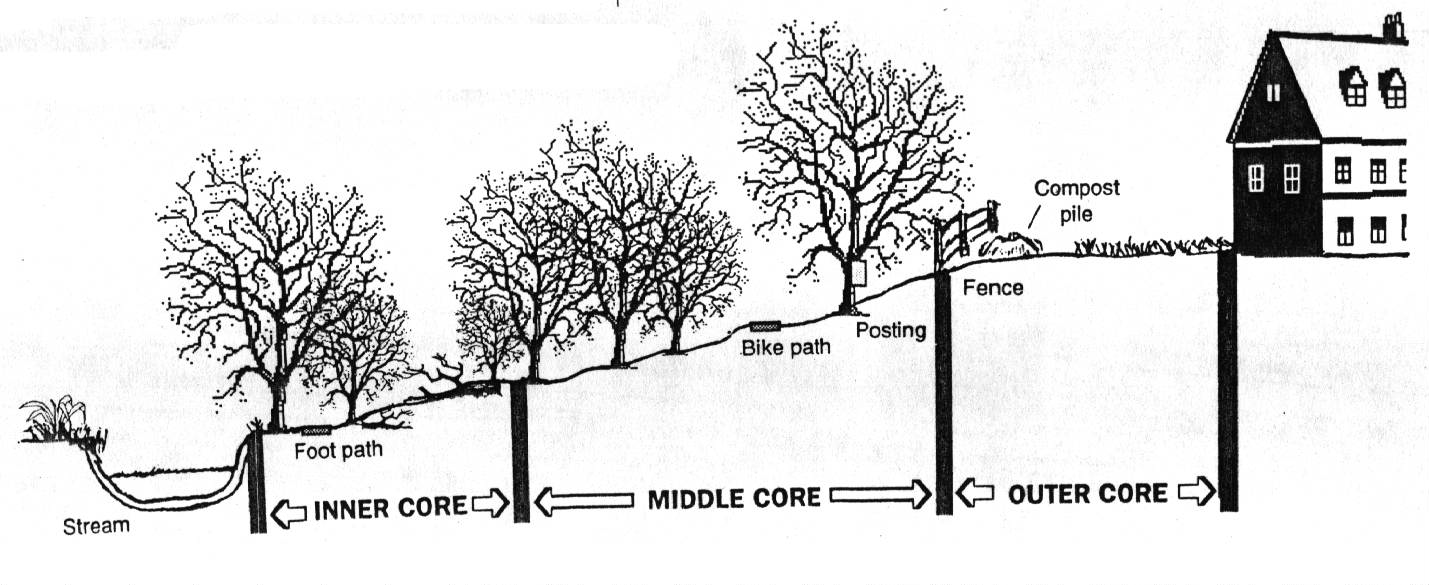 Schematic of three zone urban stream buffer system (Schueler 1995d)
Schematic of three zone urban stream buffer system (Schueler 1995d)
|
Characteristics
|
Inner Core
|
Middle Core
|
Outer Core
|
|
Width
|
Minimum of 25ft.; Must include critical habitats
|
50 to 100 feet
|
25 foot minimum
|
|
Vegetative Target
|
Mature forest (unmanaged)
|
Managed forest
|
Usually turfgrass, however, forest is ideal
|
|
Allowable Uses
|
Very restricted (utility crossings, foot paths, flood control, etc.)
|
Restricted (limited recreational activities and some BMPs)
|
Lawns, gardens, recreational fields, most BMPs, etc.
|
(Schueler 1995d)
Applications and Restrictions
- Applicable to all streams. Suitable for commercial, industrial and residential sites.
- Only effective in the treatment of stormwater when it occurs as sheetflow (i.e. not effective in the treatment of channelized flow). Sheetflow conditions cannot normally be maintained for distances greater than 150 ft. of pervious surface and 75 ft. of impervious surface (Schueler 1995d).
- Buffer width may be modified to suit existing conditions.
Active Pollutant Removal Processes
Streamside buffer zones use natural ecosystems to control stormwater quantity and quality. They provide increased surface area and extended contact time for pollutant interaction with soil and plant material. These two factors allow for enhanced pollutant removal via filtration, infiltration, microbial reactions, plant uptake and adsorption.
Estimated Pollutant Removal of Streamside Buffers
| |
Water Quality Parameter |
Removal Rate (%)
|
| |
Total Suspended Solids |
75
|
| |
Nitrogen |
50-60
|
| |
Phosphorus |
50-60
|
(Schueler 1995d)
Economic and Marketing Benefits (Schueler 1995d)
- Increase property value since the buffers are perceived as attractive amenities. 90% of buffer administrators feel that buffers have a neutral or positive impact on property values.
- Reduce complaints about backyard flooding, standing water and bank erosion.
- Protect from streambank erosion and the resulting property loss.
- Protect aquatic resources which maintains property values. A recent study of Maine lakes found that a one meter improvement in water clarity results in lakefront property being worth from $11 to $200 more per foot of shoreline (Brown and Schueler 1997a).
Maintenance
- Remove litter and large debris.
- Mow grassed areas.
- Inspect following severe storm events for evidence of erosion, sediment deposition or concentrated flow channels. Immediate action should be taken to correct any erosion problems and to restore sheet flow conditions (Welsch).
Environmental Benefits (Schueler 1995d)
- Provide effective flood control. If the year flood plain is included, buffers eliminate the need for other more expensive types of flood controls.
- Enhance pollutant removal.
- Alleviate stream warming to help maintain adequate oxygen levels in the lake.
- Protect wetlands.
- Recharge groundwater supplies providing baseflow to streams, wetlands and lakes.
Additional Benefits (Schueler 1995d)
- Provide the foundation for greenways that serve to link communities together and can serve as walking and biking trails for exercise and nature enjoyment.
- Provide food, habitat and corridors for wildlife.
- Increase the distance from the stream to areas of impervious cover, which improves septic system performance and makes more room available for placement of BMPs.
Contacts and References
- Hal Wiggins. Environmental Scientist, U.S. Army Corps of Engineers. Spotsylvania, VA. .
- Schueler, T.R.. 1995. Site Planning for Urban Stream Protection. A report prepared for Metropolitan Washington Council of Governments. Ellicott City, MD: Center for Watershed Protection.
Streamside Buffers
Fawn Lake
Significant areas of buffer zones and open space were incorporated into the site design at Fawn Lake. The lots adjacent to these areas have been receiving premiums of at least $10,000 and the development company has successfully incorporated them into their marketing strategy.
The fact that people will never have a rear-yard neighbor makes them willing to pay a premium.
- Pat Gassaway, Vice President, NTS Virginia Development Corporation (1997)
Introduction to Fawn Lake
- 2acre golf course/lake community located in Spotsylvania County, Virginia.
- Prices for lots range from $55,000 for interior lots to prices in the upper $300,000 range for waterfront lots (Melton 1997).
- As part of the mitigation plan prescribed by the Army Corps of Engineers, Fawn Lake was required to preserve, restore and construct wetlands and to establish buffer zones around the lake and its perennial streams. They also became proactive in their environmental stewardship and are now realizing an economic and marketing benefit from this.
Feature BMP: Riparian Buffers and Wetland Conservation Areas (Wiggins 1997)
- 365 acres of preserved uplands (includes uplands within lots and open space).
- 48.5 acres of restored and constructed wetlands.
- 75 to 100 foot buffer applied to Fawn Lake and its perennial streams.
- Total preservation area of 464 acres in buffer zones and open space.
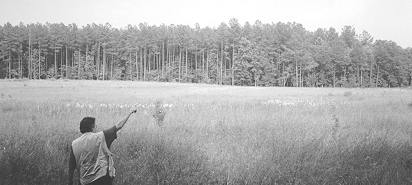
View from a conservation lot in Fawn Lake selling for a premium
Economic and Marketing Benefits
Buyers feel that they are never going to be intruded upon by someone behind [them] and that's worth a premium. [It is] very important to customers to live in a place that doesn't harm nature and in a community that includes wildlife such as turkey and deer (Gassaway 1997).
- Received a premium of $10,000 or more for lots adjacent to buffer zones or other open space as compared to interior lots of comparable size. These lots are marketed as conservation lots. Golf course and lakefront lots sell for an additional premium (Melton 1997).
- Attractive views from homes and roadways and preservation of rural atmosphere.
- Environmental friendliness is a feature selling point of the community when potential buyers visit Fawn Lake. They use "buzz words" in marketing such as wetlands preservation, habitat management and open space (Gassaway 1997).
Environmental Benefits
- Enhance pollutant removal to protect Fawn Lake from algal blooms and fish kills.

View from a home in Fawn Lake adjacent to a conservation area
Comments (Gassaway 1997)
Fawn Lake is also very active in preserving the water quality of their lake. According to Pat Gassaway, the value of the lake is priceless and the two greatest concerns of Fawn Lake residents are preserving the habitat value of the lake and the impact the golf course will have on it. Therefore, an integrated pest management program has been implemented on the course and a well-designed system of BMPs has been installed. Fawn Lake makes it clear to potential buyers that they are very involved in preserving the lake and that they have taken special precautions such as buffer areas, enhanced BMPs and integrated pest management to do so. This gives buyers a feeling of security in knowing that their property values will be preserved.
Contacts and References
- B. Patrick Gassaway. Vice President of Fawn Lake, NTS Virginia Development Corporation. Spotsylvania, VA. .
- Ken Melton. Sales Executive for Fawn Lake, NTS Development Corporation. Spotsylvania, VA. .
- Hal Wiggins. Environmental Scientist, U.S. Army Corps of Engineers. Spotsylvania, VA. .
Open Space (Cluster) Development
Open Space Development is a site design option where house lots are concentrated in specific zones of the development, leaving significant areas of common open space for preservation, recreation, agriculture and wildlife habitat. This significantly reduces development costs while maintaining or increasing property values.
Cluster development offers many advantages over conventional subdivision design and should not only be allowed, but encouraged.
- National Association of Home Builders (1997)
Open space development provides permanently protected open space (for recreation, wildlife, agriculture), which adds tangible economic value to individual house lots. Best of all, the increased value is created at no additional cost to the developer.
- Randall Arendt, Natural Lands Trust (1991)
Introduction
- Type of development where lot sizes are minimized within a few compact portions of the property while large portions of the development (10%-80%) are maintained as open space.
- Allows developers to build the same number of homes that would be found if the site were developed under current zoning regulations. Houses are simply placed on smaller lots and concentrated in certain areas, therefore consuming less land and requiring less infrastructure.
- Designed to permanently preserve farmland, wetlands, stream buffer zones, recreation areas and forests and to reduce the total amount of impervious surfaces in the development.
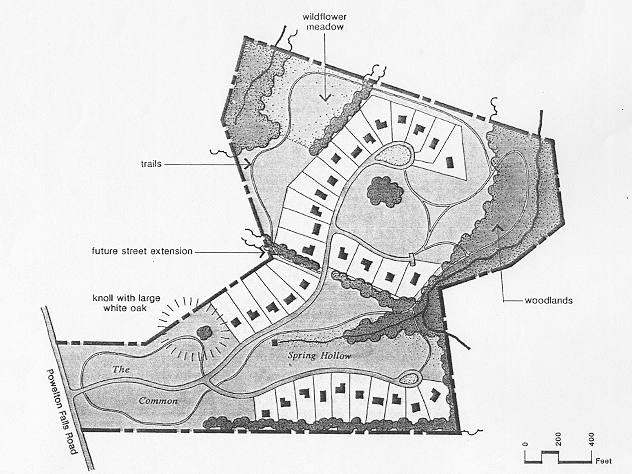
Schematic of an open space subdivision (Arendt 1996)
Construction (Schueler 1995d)
- Linear impervious surfaces (driveways, streets, sidewalks) constitute approximately half the cost of residential subdivision construction. Total road length can be decreased by 50 to 75% in cluster developments.
- Water and sewer lines are shortened as road length declines.
- Requirements for BMPs and storm drain pipes will be decreased as their capacity is a function of site imperviousness.
Unit Cost Estimates of a Typical Subdivision Development
|
Subdivision Improvement
|
Unit Cost
|
| Roads, Grading |
$22.00 per linear foot |
| Roads, Paving (26 feet width) |
$71.50 per linear foot |
| Roads, Curb and Gutter |
$12.50 per linear foot |
| Total Cost of Road Construction |
$106.00 per linear foot |
| Sidewalks (4 feet wide) |
$10.00 per linear foot |
| Storm Sewer (24 inch) |
$23.50 per linear foot |
| Driveway Aprons |
$500 per apron |
| Parking Spaces |
$1,100 per parking space ($2.75/ft2) |
| Clearing (forest) |
$4,000 per acre |
| Sediment Control |
$800 per acre |
| Stormwater Management |
$5,000 to $60,000 per impervious acre |
| Water/Sewer |
$5,000 per lot (variable) |
| Well/Septic |
$5,000 per lot (variable) |
(Schueler 1995d)
Applications and Restrictions
- Applies only to residential developments.
- Most suited for developments greater than 10 acres.
- Must be an accepted development alternative as set forth by local ordinances.
Economic and Marketing Benefits
- May help a developer recover a salable lot that might have otherwise been lost to protect a sensitive environmental area (Schueler 1995d). For example, some sections of a tract may be unbuildable due to environmental constraints. These areas would normally be a loss to the developer, however, by clustering the homes on buildable areas, the developer may be able to recover these lots.
- Increases future property values since homes bordering properly planned and maintained open or green space appreciate at a faster rate than traditional residential subdivision properties (Schueler 1995d).
- Provides a marketing and sales advantages. Potential buyers can be told that they are not only buying a lot and a home, but also the right to use all of the open and green space in the subdivision (Arendt 1996).
- Reduces capital costs by 10 to 33% by reducing impervious cover by 10 to 50% and by reducing the amount of land that has to be cleared for construction by 35 to 60%.
- Reduces the cost of future public services (Schueler 1995d).
- Provides more potential sites for placement of stormwater BMPs (Schueler 1995d).
Tips for Reducing Impervious Areas and Costs (NVa PDC 1996)
- Utilize donut style or "T" shaped cul-de-sac.
- Reduce street widths and building setbacks.
- Minimize parking lot and driveway size.
- Reduce the building footprint (minimizes clearing).
Environmental Benefits
- Reduces the amount of impervious cover, which results in improved quality and decreased quantity of stormwater runoff.
- Preserves 25% to 50% of a development site in its natural condition or as open space such as wetlands, woods, farmland and ponds (Schueler 1995d).
- Protects upland buffers along wetlands and streams that would be cleared, graded and developed under conventional practices (Arendt 1996).
- Provides opportunities for implementation of environmentally sensitive sewage treatment and disposal systems (Arendt 1996).
Additional Benefits
- Increases the sense of community and preserves the rural character and aesthetic qualities associated with natural conditions and open spaces.
- Reserves up to 15% of a site for active or passive community recreation (Schueler 1995d).
- Creates urban wildlife habitat areas for viewing by residents. Upland buffer zones offer our best hope for creating a system of interconnecting corridors for all types of wildlife as they travel between larger habitat areas (Arendt 1996).
Comments
Randall Arendt of the Natural Lands Trust believes that open space development will be in great demand in the future for two reasons. (1) "Baby boomers" are now becoming empty nesters as their children leave the home. This means that they no longer need or want large yards or house lots which must be maintained, however they desire to remain in a rural atmosphere. (2) Single parent homes are becoming more and more prevalent. These single parents do not have the time to maintain a large yard or lot yet they still desire for their children to have access to these types of facilities.
Contacts and References
- Randall Arendt. Natural Lands Trust. Media, PA. .
- Arendt, R.G. 1991. Cluster development: A profitable way to save open space. Land Development Magazine (Fall): 26-30.
- Arendt, R.G. 1994. Rural by Design: Maintaining Small Town Character.
- Arendt, R.G. 1996. Conservation Designs for Subdivisions: A Practical Guide to Creating Open Space Networks. Washington, DC: Island Press.
- Maurer, G. 1996. A Better Way To Grow-For More Livable Communities and a Healthier Chesapeake Bay. Annapolis, MD: Chesapeake Bay Foundation.
- Schueler, T.R. 1995. Site Planning for Urban Stream Protection. A report prepared for Metropolitan Washington Council of Governments. Ellicott City, MD: Center for Watershed Protection.
Open Space (Cluster) Development
Northridge
The developer of this project used an innovative site design that preserved significant areas of open space. As a result of this design and other innovative construction measures, he realized a cost savings of approximately $5 million as well as other sales and marketing benefits.
Generally people will pay a premium for wooded lots and a rural atmosphere.
- Bob Kaufman, Developer, Michael T. Rose Development Co., Inc. (1997b)
Introduction to Northridge
- unit residential development on 350 acres. Residential units include townhouses, detached single units and condominiums.
- Located in the City of Bowie, Maryland (Prince George's County).
Feature BMP: Innovative Open Space Design Aimed at Preserving Rural Character
- Concentrated zones of development in order to preserve significant areas of open space.
- Replaced curb and gutter with grassed drainage swales in all but the higher density areas.
- Utilized donut style cul-de-sacs which left tree and vegetation islands in order to reduce imperviousness, serve as the court's center of focus and ease the appearance of the cul-de-sac.
- Replaced sidewalks with an internal walkway system that served as a walking/biking and nature trail.
- Utilized a 2:1 slope as opposed to the 3:1 standard. This minimized disturbance by preventing the unnecessary destruction of trees and terrain features. The steeper slopes were stabilized with fiber mats or netting and replanted with appropriate vegetation.
- Allowed a 4 foot minimum setback from building pads instead of the normal 10 foot minimum. This protected more of the existing environment and prevented unnecessary grading.
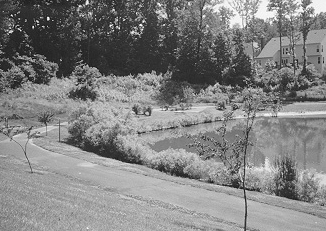
BMP and scenic wet pond
Economic and Marketing Benefits
[The] most important [concern] is acceleration of sales. Instead of lowering prices to increase the sales pace, we put our cost savings back into the value of the land in order to accelerate sales (Kaufman 1997b).
- Saved approximately 5 million dollars (about 12% of development costs) using the innovative site design and alternative construction measures (Kaufman 1997b).
- Marketed as a community set against a stunning natural backdrop of our forests and lake where you can relax in the shade of 100 year-old trees and buy a home which was built in harmony with nature (Northridge 1995a,b).
- Applied the 5 million dollar cost savings to improvements within the development including the construction of a wet pond, nature trail, brick pavers at specified intersections, stone guardrails, stone faces on culverts and brick and stone entry signs.
- Achieved an above average buildout rate for the area of 125 homes per year (Kaufman 1997b).
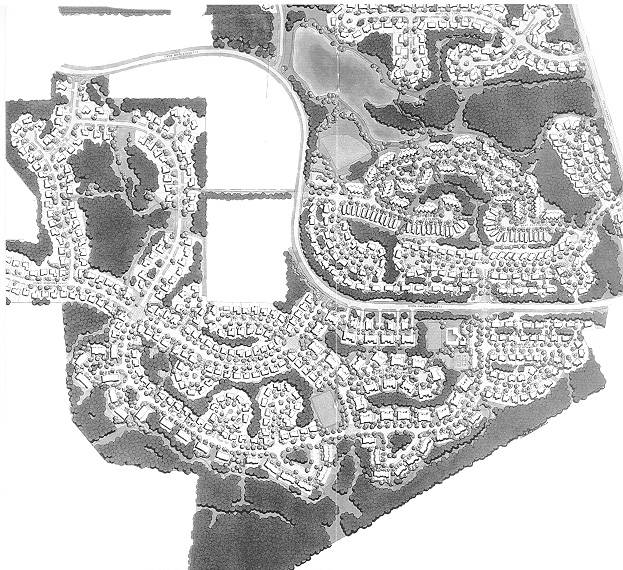
Site plan for Northridge (Northridge 1995b)
Maintenance
- Mow grassed swales (generally performed by homeowners) and recreation areas.
- Maintain the lake (see Chapter 2 on wet ponds).
Environmental Benefits
- Use of the wet pond as the BMP for part of the development.
- Use of grassed swales in place of curb-and-gutter to provide for on-site treatment and infiltration.
Additional Benefits
- Provides recreation areas and facilities.
Contacts and References
- Bob Kaufman. National Vice President, Michael T. Rose Consulting Co., Inc. Laurel, MD.
- Northridge Team, The. 1995. Northridge: Built From Nature's Blueprints, sales brochure. Michael T. Rose Companies, Inc. Laurel, MD.
- Petit, J., D.L. Bassert, and C. Kollin. 1995. Building Greener Neighborhoods-Trees as Part of the Plan. Washington, DC: American Forests/Home Builder Press, National Association of Home Builders.
Open Space (Cluster) Development
Farmcolony
The developer of this residential project concentrated the houses in certain areas in order to preserve a working farm as the development's focus. This provided the residents with all the benefits of rural, farm life (scenery, tranquillity, etc.) without the associated work or expenses.
I think it's the most successful project that I had done in my career. I thought it'd be an ideal place for people to live.
- Gilbert Edward, Developer, Farmcolony (Weiss 1991)
This is a place where you can live on a farm and enjoy all the benefits of rural farm life without having to do all the work. That was the theme of the developer's marketing strategy, and it's the truth.
- Don Thurnau, 20 yr. resident, Secretary of Farmcolony HOA, and Former Farm Manager (1997)
Introduction to Farmcolony
- acre, 48-lot residential community focused around a acre working farm. Located four miles southwest of Stanardsville in Greene County, Virginia.
- Developed in the mid-1970s by real estate developer Gilbert Edwards.
- Farm contains pastureland, hayfields, horse and hay barns, a ¾-acre garden, 5 fishing ponds, a show ring and other farm buildings for the storage of equipment and feed.
- Average lot size is 2 acres and lot resales currently average $25,000 (Thurnau 1997).
Feature BMP: Innovative Open Space Plan Designed to Preserve Rural Character of the Existing Farm
- Concentrated zones of development in order to preserve viewshed and significant areas of farmland and open space. Lots were reduced from the required 5 acres to an average of 2 acres. This allowed for the preservation of the farmland and woodlands while allowing the developer to maintain his overall density.
- Preserved 50% of the site as active agricultural areas and 36% (79 acres) as a wooded mountain preserve. These areas are owned and maintained by the homeowners' association.
- Residential lots were sited in the unfarmable sections of the property that were steeply sloped and wooded. This ensured that the homes would be hidden from the state road that bordered the farm, from neighboring properties and from the farm itself.
Economic and Marketing Benefits
- Marketed as a place where a person can enjoy all the benefits of living on a farm without the responsibilities and at a much cheaper cost than buying a farm individually (Thurnau 1997).
- Attracts all types of residents from young professionals to single working mothers to retired folks with the low responsibility farm life concept that it was founded upon (Thurnau 1997).
Construction
- Total development costs were approximately $370,000 (ULI 1992).
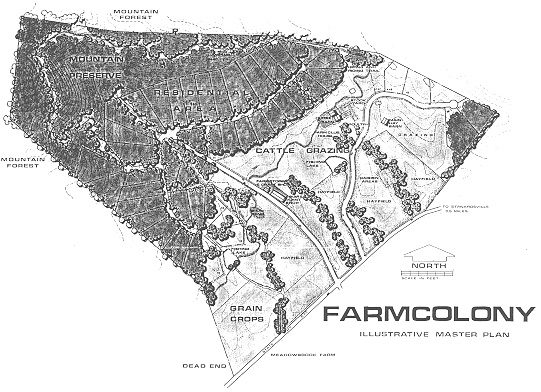
Site design for Farmcolony
Maintenance
- Ownership of property within Farmcolony entitles one to joint ownership of the farm through the homeowners' association. The association holds title to the agricultural areas, mountain preserve, twelve buildings, livestock, machinery and equipment. Actual day-to-day operation of the farm is handled by residents on a volunteer basis.
- Annual maintenance costs are approximately $16,000 (ULI 1992).
- Require residents to participate in a work day to do farm chores and maintenance projects twice a year (Weiss 1991).
Environmental Benefits
- Use of the wet ponds as the BMPs for the development.
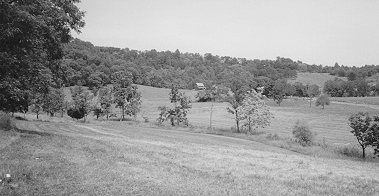
View of Farmcolony from the adjacent state road
Additional Benefits
- Availability of fresh eggs, produce, beef and lamb for residents to purchase at cost from their own farm (Thurnau 1997).
- Provides recreation and social areas and facilities including the original restored farmhouse which hosts functions and has private bedrooms where residents and their guests are welcome to stay (Thurnau 1997).
Comments
Florida based developer Gilbert Edwards states that Farmcolony was his best project. He says that every farm has a bunch of acreage that isn't usable for farming that's perfect for houses (Weiss 1991). Mr. and Mrs. Thurnau both state that Farmcolony (and cluster developments like it) are the perfect compromise because they offer country living with the convenience and security of having close neighbors (Weiss 1991). Many other residents agree that this is an excellent trade-off between the conveniences of city living and the tranquillity of country life (Thurnau 1997). Randall Arendt of the Natural Lands Trust and many Farmcolony residents believe that Farmcolony's only flaw is that many of the lots could have been made smaller. Mr. Thurnau states that most of the residents who have lots that extend into the pastureland simply allow the cattle to graze on their lots so that they don't have to mow them (Thurnau 1997). This extra acreage could have been incorporated into the common open space.

View from a Farmcolony resident's home
Contacts and References
- Randall Arendt. Natural Lands Trust. Media, PA. .
- Don Thurnau. Resident, Secretary of Farmcolony HOA and Retired Farm Manager. Stanardsville, VA. .
Open Space (Cluster) Development
English Meadows
The developer of this residential project concentrated the houses in certain areas in order to preserve 6 "farmettes". These farmettes are 25- to 50-acre working farms which are privately owned and maintained but are protected from future development. This provides the residents of English Meadows with all the benefits of rural farm life without the associated work or expenses.
Residents love to overlook the farms and see the animals and crops.
- Bob Sowder, Developer, English Meadows (1997)
Introduction to English Meadows
- acre residential development in Fauquier County, VA. Developed in 1987.
Feature BMP: Innovative Open Space Plan Designed to Preserve Rural Character of the Existing Farm
- Zoned 5-acre residential, which allowed the developer to delineate 62 5-acre lots by right. Instead, he planned 57 lots with an average size of 1.4 acres; the remaining land was broken into 6 "farmettes" ranging in size from 26 to 53 acres (Sowder 1997).
- Designed each of these farmettes except one with a house site, giving the development its maximum number of houses.
- Sold the farmettes, which are now being used to grow corn, soybeans and hay and as pastureland for horses and sheep (Sowder 1997). They are protected from future development.
- Included 6.63 acres of common open space (Sowder 1997).
Site design for English Meadows
Economic and Marketing Benefits
I marketed quality of life at English Meadows. People know that the field behind them is going to be used for agriculture in the future, and that they don't have to maintain it or pay taxes on it. The innovative site design is more of a benefit now than it was to me at the time because there are people in the county whom I can go to and say 'look at the example [of my work] at English Meadows' (Sowder 1997).
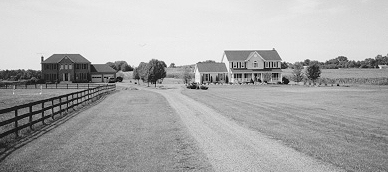
View of two English Meadows homes with adjacent farmland
Maintenance (Sowder 1997)
- Farmettes are maintained by their owners, while the residential part of the subdivision is maintained by the homeowners' association.
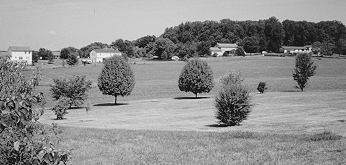
View of agricultural land from a resident's backyard
Comments (Sowder 1997)
Mr. Sowder's original motive to cluster the homes in English Meadows was to better utilize the soils and minimize development costs. He states that he was very pleased with the final outcome and has done several similar projects since then, including Ivy Hill, another good example of an open space development. He also adds that open space subdivisions are much safer for residents, especially children. However, he does list a few drawbacks. The major problem he had with English Meadows was designing it around house sites that had suitable soils for individual septic sewage disposal systems. The layout of the subdivision was driven largely by this restriction. Mr. Sowder states that had he been allowed to use a pump driven system instead of the required gravity feed system, he would have been able to design a much more efficient layout for both the residential and agricultural areas. Additionally, he states that the use of the farmettes must be restricted so that they do not turn into large commercial farming operations that are a nuisance to residents. The final drawback with English Meadows is that it is highly visible from adjacent state roads. This is due to the lack of trees in the formally agricultural field, and also to the septic system limitations previously mentioned.
Contacts and References
- Randall Arendt. Natural Lands Trust. Media, PA. .
- Bob Sowder. President, Sentry Realty Inc. Warrenton, VA. .
Special Golf Course Techniques
Special Golf Course Techniques involve the use of stormwater BMPs in ways that are best suited for golf course design. This is because the golf course can be planned with a series of BMPs whose total effectiveness meets the water quality requirements. If planned correctly, the BMPs on a golf course can compensate for the lack of them in denser areas.
We have less BMPs in the town center where it is more costly because the more developed an area the more expensive the BMP. This is balanced by having more BMPs in the golf course.
- Jason Vickers-Smith, Project manager, Belmont Development Corporation (1999a)
Introduction
- Area must be planned as a comprehensive unit for stormwater management.
- Allows developers to decrease the amount of BMPs in urban areas within the watershed.
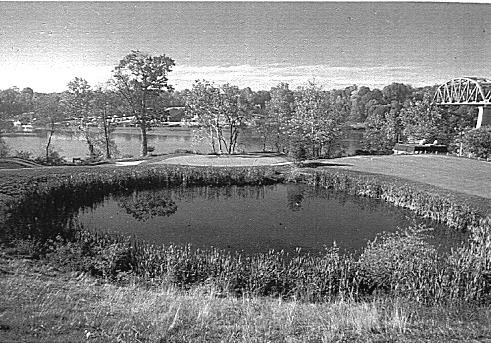
Wet pond as part of a golf course BMP (Cox Co. 1999)
Applications and Restrictions (Cox Co. 1999; Klein 1993)
- Each BMP needs to work within the physical limitations of the site to achieve overall management of the stormwater.
- BMP must be constructed on areas that allow for their correct functioning in order to avoid costly maintenance problems.
- Site should be designed to minimize disturbance to natural habitats.
- The number of waterway crossings should be minimized and bridges should be constructed of permeable material.
- Underdrains should be placed in areas where groundwater contamination from leachate may occur.
Environmental Benefits
- Preferable to impervious surfaces for allowing filtration of stormwater and removal of pollutants.
- Integrated pest management decreases the need for pesticides, which along with slow release fertilizers, decreases the pollutant load in the runoff water.
Contacts and References
- Frank Cox. Engineer/Landscape Architect, The Cox Company. Charlottesville, VA. .
- Tom Grizzard. Virginia Tech Extension Service. Manassas, VA. ext.112.
Special Golf Course Techniques
Belmont Bay
Case Study Under Construction
Data Gathering in Progress
The Belmont Bay community and town center have an integrated set of BMP measures to respond to Prince William County's goal of maintaining and improving water quality in the Occoquan River. The objectives in the BMP design were not only to maximize pollutant removal, but also to minimize initial construction costs and the future maintenance burden.
We saved in the millions because less land was wasted and we did not have to build the concrete structures required in dense areas for stormwater management.
- Jason Vickers-Smith, Project manager, Belmont Development Corporation (1999b)
Introduction to Belmont Bay (Belmont 1998)
- A acre sustainably designed mixed-use development, combining residential, office, retail and recreational uses including an environmentally sensitive 18-hole golf course.
- Located 18 miles southwest of Washington, DC in Prince William County and adjacent to the acre Occoquan Bay National Wildlife Refuge and the Occoquan River.
- Uses various BMPs in a series to achieve the greatest efficiency in pollutant removal.
- Serves the stormwater needs of surrounding residential communities and industries.
- Single-family homes with a water view and on the golf course sell for $400,000. Townhomes sell for $175,000.
Feature BMP: BMPs in series (Cox Co. 1999)
The BMPs work in a series of wet ponds, infiltration bunkers, filter strips and grassed swales. Included in the BMP calculations is a drainage trench that was reconfigured to mimic a natural stream. Wetlands also provide stormwater quality improvements but are not included in the BMP calculations.
- The wet ponds serve as sediment holding areas for surface runoff on the golf course and hold the water collected in the infiltration chambers. The water is treated by the wet pond ecosystem and it is then used as irrigation for the golf course. Eventually this water will be released into the Occoquan River.

Schematic of wet pond (Cox Co. 1999)

Stormwater wet pond on golf course (Cox Co. 1999)
- The infiltration bunkers are infiltration trenches or basins that look like sand traps or turfed bunkers. They are constructed with a layer of filter sand on top and underlain by rock with the outflow leaving via a drainage pipe. These bunkers were also used to serve the development of the golf course within the foot buffer of the RPA. The site was graded away from the river so the runoff did not go into the river before infiltrating through the bunker.

Schematic of infiltration bunker (Cox Co. 1999)
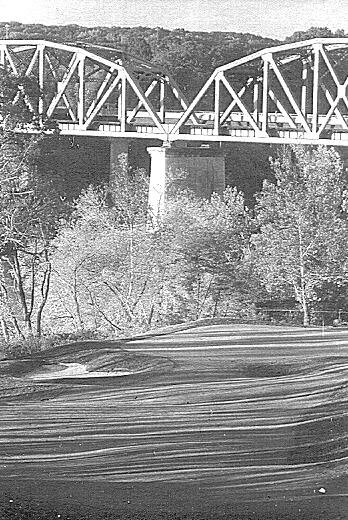
Infiltration bunker on golf course (Cox Co. 1999)
- Water flows from the residential areas over the golf course which serves as a filter strip before the water reaches the wet pond or the river.
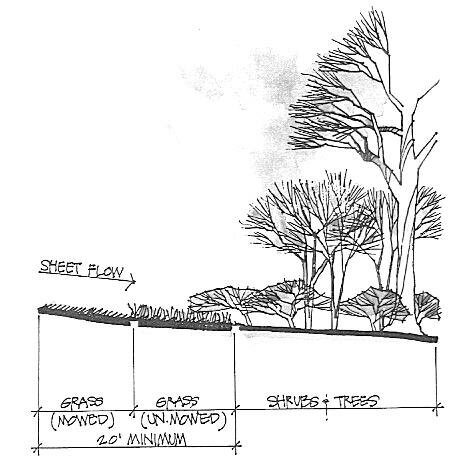
Schematic of filter strip (Cox Co. 1999)
- The grassed swales slope off the roadways and serve as curb and gutter.

Schematic of grass swale (Cox Co. 1999)
- The redesigned stream channel was a project involving the Woodbridge Institute for Sustainable Ecosystems. The drainage ditch leading from the school was reconfigured to meander like a natural stream to achieve biofiltration benefits. The bottom was flattened, check dams were added and vegetation was planted to produce a biological BMP.
Economic and Marketing Benefits
- The proximity to the Occoquan River and National Wildlife Refuge provides the opportunity for positive public relations. I hope that people will look at it and appreciate our sensitivity to the environment in all the things we have done (Caruthers 1999).
- Marketed the environmentally sensitive golf course to prospective buyers. When I take out home buyers and they ask why someone is trying to hit their ball out of that funny looking thing, I will explain to them that it is an infiltration bunker that is helping to protect water quality (Caruthers 1999).
- Achieved cost savings by avoiding the expensive ultra-urban BMPs. You don't have the extra cost of putting in BMPs near the homes. The cost of the golf course is slightly more, but not as expensive as putting them [BMPs] in urban areas so the economic benefits are realized in the long term when the homes are built (Vickers-Smith 1999a).
- Reclaimed between 3 and 5 townhouse lots by building the stormwater pond that serves the homes on the golf course instead of in the residential area.
- Opened the golf course before completion of the site in order to generate income to support the continuing development of homes that take longer to produce economic returns.
- The irrigation pond provides water for the golf course during drought times when drinking water is scarce and helps them to avoid the high fees associated with tapping into the city's water supply.
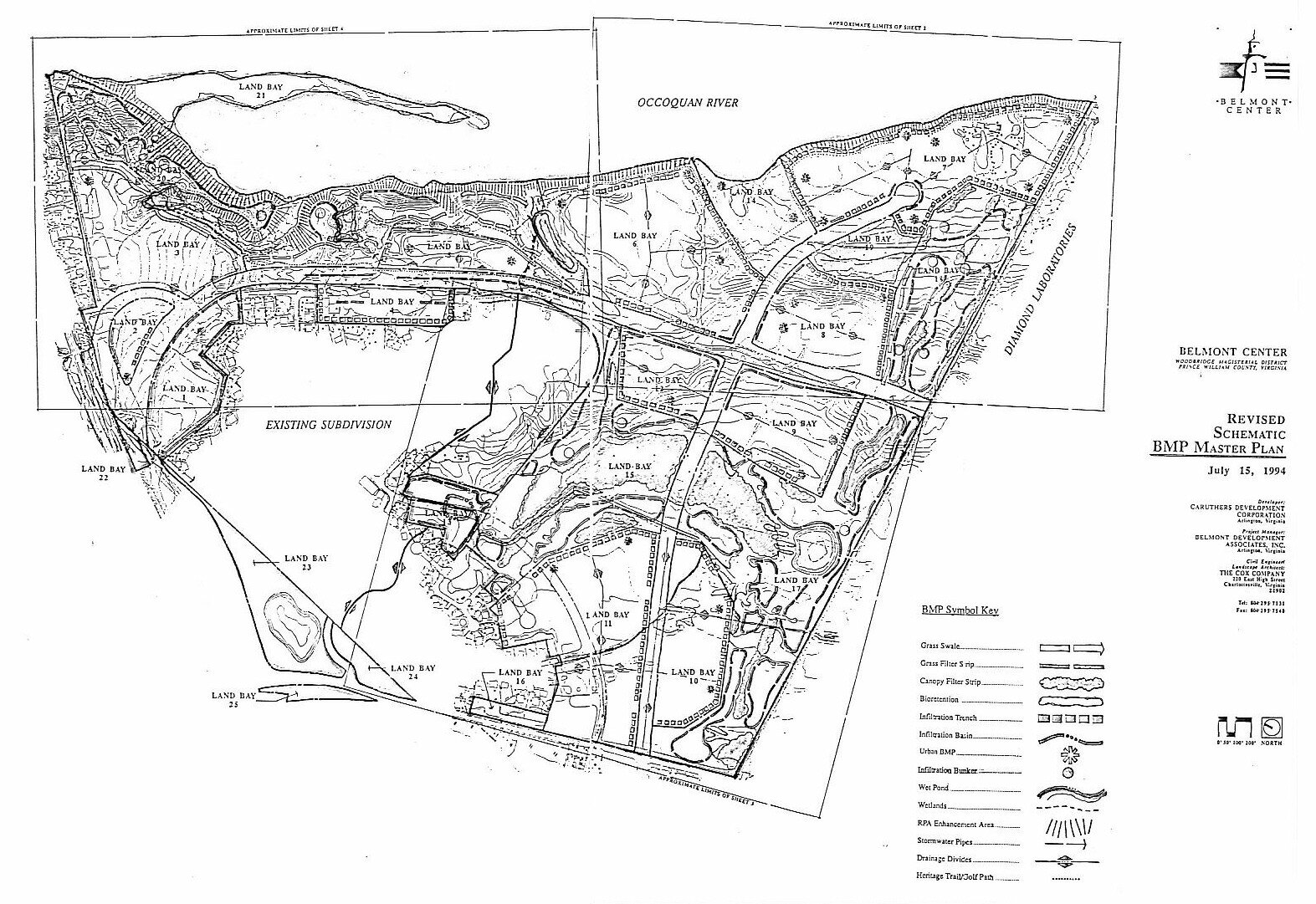
Site design for Belmont Bay (Cox Co. 1999)
Construction
- Built the course around existing wetlands and other natural features thus providing soft edges that are more aesthetically pleasing.
- Completed construction of the golf course first to include the BMPs that will serve existing and future development, therefore BMPs did not need to be considered on a site by site basis.
Maintenance (Cox Co. 1999)
- Maintenance of this golf course is very similar to that required on other golf courses with ponds and bunkers that are simply for aesthetics.
Wet ponds
- Mow surrounding areas no less than twice a year.
- Inspect annually to ensure correct operation.
- Remove debris and litter.
- Correct any erosion problems.
Infiltration bunkers
- Turfing made them easier to maintain and more attractive.
- Inspect annually for cracking, erosion, uneven settlement, ponding, sediment accumulation, bare spots and leakage.
Filter strips
- Maintain the edges to prevent channel flow.
- If not forested, mow two or three times a year.
- Remove accumulated sediment.
Grassed swales
- Maintain a dense, vigorous turf.
Redesigned stream channel
- Maintain a dense vegetation.
- Repair bare spots along the streambank.
- Remove debris and litter.
Environmental Benefits (Cox Co. 1999)
- Maintains the predevelopment hydrograph.
- Recharges the groundwater within the land bays and wetlands.
- Reduces pollutant levels to enhance overall water quality on- and off-site.
- Use of BMPs in series increases the pollutant removal efficiency.
Additional Benefits
- Solves environmental problems from the outset so they do not have to be addressed with each site plan. The process goes smoother since we don't have to address every issue every time (Vickers-Smith 1999b).
- Enhances the aesthetics of the golf course.
- Provides wildlife habitat in forested areas, wetlands, wet ponds and streams.
Contacts and References
- Preston Caruthers. Developer, Caruthers Development Corporation. Arlington, VA. .
- Frank Cox. Engineer/Landscape Architect, The Cox Company. Charlottesville, VA. .
- Dennis Shiflett. Director, Woodbridge Institute for Sustainability. Woodbridge, VA.
- Jason Vickers-Smith. Project Manager, Belmont Development Corporation. Occoquan, VA. .
- Belmont Bay Development. 1998. History, Location, and a Vision of Tomorrow Come Together at Belmont Bay, sales brochure. Belmont Bay, VA.
- Cox Company, The. 1999. Best Management Practices Master Plan & Design Guidelines Belmont Bay Community. March. Charlottesville, VA: The Cox Company.
References
Anacostia Restoration Team. T.R. Schueler, P.A. Kumble, and M.A. Heraty. 1992. A
Current Assessment of Urban Best Management Practices. A report prepared for
USEPA Office of Wetlands, Oceans, and Watersheds. Washington, DC:
Metropolitan Washington Council of Governments.
Arendt, R.G. 1991. Cluster development: A profitable way to save open space. Land
Development Magazine (Fall): 26-30.
--------. 1994. Rural by Design: Maintaining Small Town Character.
--------. 1996. Conservation Designs for Subdivisions: A Practical Guide to Creating Open
Space Networks. Washington, DC: Island Press.
Bassert, D. 1991. Cluster development: An old concept gains new followers. Land
Development Magazine (Winter).
Bell, Warren. 1997. Personal interview by Christopher M. Collins, written records. City of
Alexandria Department of Transportation and Environmental Services.
Alexandria, VA. 29 May.
Bell, W., L. Stokes, L.J. Gavan, and T.N. Nguyen. 1996. Assessment of the Pollutant
Removal Efficiencies of Delaware Sand Filter BMPs. City of Alexandria
Department of Transportation and Environmental Services. Alexandria, VA.
Belmont Bay Development. 1998. History, Location, and a Vision of Tomorrow Come
Together at Belmont Bay, sales brochure. Belmont Bay, VA.
Brown, W. and T.R. Schueler. 1997. The Economics of Stormwater BMPs in the Mid-
Atlantic Region. A report prepared for Chesapeake Research Consortium, Inc.
Ellicott City, MD: Center for Watershed Protection.
--------. 1997. National Pollutant Removal Performance Database for Stormwater BMPs.
A report prepared for Chesapeake Research Consortium, Inc. Ellicott City, MD:
Center for Watershed Protection.
Caraco, D., R. Claytor, and J. Zielinski. 1998. Nutrient Loading from Conventional and
Innovative Site Development. A report prepared for Chesapeake Research
Consortium, Inc. July. Ellicott City, MD: Center for Watershed Protection.
Caruthers, Preston. 1999. Phone interview by Crystal G. Lovett. Developer with
Caruthers Development Corporation. Arlington, VA. 22 July.
Claytor, R.A. and T.R. Schueler. 1996. Design of Stormwater Filtering Systems. A
report prepared for Chesapeake Research Consortium, Inc. December. Ellicott
City, MD: Center for Watershed Protection.
Coffman, Larry. 1997. Personal interview by Christopher M. Collins, written records.
Prince George's County Department of Environmental Resources. Landover,
MD. 10 June.
Cole, Nelson. 1997. Phone interview by Christopher M. Collins, written records. Project
Manager with Lee's Hill Partnership. Fredericksburg, VA. 21 July.
Cox Company, The. 1999. Best Management Practices Master Plan & Design
Guidelines Belmont Bay Community. March. Charlottesville, VA: The Cox Company.
Cox, Frank. 1999. Phone interview by Crystal G. Lovett. Engineer/Landscape Architect
with The Cox Company. Charlottesville, VA. 4 August.
CULTEC Environmental Technologies. 1999. CULTEC Chamber System, sales
brochure. CULTEC Environmental Technologies. Occoquan, VA.
Curry, W.K. and S.E. Wynkoop, eds. 1995. "How does your Garden Grow?": A
Reference Guide to Enhancing Your Rain Garden. Landover, MD: Prince
George's County Department of Environmental Resources.
Daniels, L. 1995. Maryland developer grows "Rain Gardens" to control residential
runoff. Nonpoint Source News-Notes 42 (August/September): 5-7.
Davis, A. P., M. Shokouhian, H. Sharma, and C. Minami. 1998. Optimization of
Bioretention Design for Water Quality and Hydrologic Characteristics. A report
prepared for Prince George's County Watershed Protection Branch. June.
College Park, MD: University of Maryland.
Ellen, William B. 1997. Phone interview by Raymond de Leon, written records. President
of William B. Ellen Co., Inc. Matthews, VA. 26 June.
--------. 1997. Phone interview by Raymond de Leon, written records. President of
William B. Ellen Co., Inc. Matthews, VA. 21 July.
Elliot, Jules. 1997. Phone interview by Christopher M. Collins, written records. President
of Old Colony Homes, Inc. Fredericksburg, VA. 30 June.
Engineering Technologies Associates, Inc. and Biohabitats, Inc. 1993. Design Manual for
the Use of Bioretention in Stormwater Management. A report prepared for Prince
George's County Watershed Protection Branch. June. Landover, MD: Prince
George's County Department of Environmental Resources.
Expert Object Corporation. 1999. Improving mosquito management. McHenry County
Defenders. May. <http//www.mcdef.org/mos.htm> (27 August 1999).
Firehock, K. and J. Doherty. 1995. A Citizen's Streambank Restoration Handbook.
Gaithersburg, MD: Save Our Streams Program, Izaak Walton League of America,
Inc.
Fisher, K.M. 1998. Capital One Parking Lot Expansion: Stormdrain profile and details.
Project manager with McKinney & Co. Ashland, VA.
Flora, Deborah. 1997. Personal interview by Christopher M. Collins, written records.
Sales Manager for Chancery Associates, Limited. Alexandria, VA. 22July.
Foss, Gary. 1997. Phone interview by Christopher M. Collins, written records.
Superintendent of Fredericksburg Christian School System. Fredericksburg, VA.
23 July.
Frederick, R., R. Goo, M.B. Corrigan, S. Bartlow, and M. Billingsley. Tetra Tech, Inc.
1995. Economic benefits of runoff controls. Nonpoint Source Pollution Control
Program. A report prepared for U.S. Environmental Protection Agency, Office of
Water. September. Revised 30 December 1997.
<http://www.epa.gov/OWOW/NPS/runoff.html> (27 August 1999).
Gassaway, B. Patrick. 1997. Personal interview by Christopher M. Collins, written
records. Vice President of NTS Development Company, Inc. Spotsylvania, VA.
25 June.
Harper, Kenneth. 1997. Phone interview by Christopher M. Collins, written records.
Department of Conservation and Recreation. Richmond, VA. 5 August.
Hilsenwrath, E. and K. Zachary. 1996. Learning from nature: Alternative approaches to
stormwater management. Land Development Magazine (Winter): 21-26.
Howland, M.A. 1996. Natural plantings to enhance mosquito control in wetland areas.
Land and Water (Sept./Oct): 45-48.
Kaufman, S. Robert. 1997. Phone interview by Christopher M. Collins, written records.
National Vice President of Michael T. Rose Consulting Co., Inc. Laurel, MD. 17 June.
--------. 1997. Personal interview by Christopher M. Collins, written records. National Vice
President of Michael T. Rose Consulting Co., Inc. Laurel, MD. 24 June.
Keller, R.J. 1997. Phone interview by Christopher M. Collins, written records. Consultant
with R.C. Fields Jr. and Associates, P.C. Alexandria, VA. 1 July.
Klein, Richard. 1993. Protecting the Aquatic Environment from the Effects of Golf
Courses. October. Maryland Line, MD: Community & Environmental Defense
Services.
Kuo, C.Y., G.D. Boardman, and K.T. Laptos. 1990. Phosphorus and Nitrogen Removal
Efficiencies of Infiltration Trenches. A report prepared for Northern Virginia
Planning District Commission, Occoquan Technical Advisory Committee and
Virginia State Water Control Board. November. Blacksburg, VA: Virginia
Polytechnic Institute & State University.
Laurent, S., ed. 1992. Engineering Field Handbook-Chapter 18: Soil Bioengineering for
Upland Slope Protection and Erosion Reduction. October. Washington, DC:
U.S. Department of Agriculture, Soil Conservation Service.
Lovett, Crystal. 1999. Curb and Gutter vs. "Engineered Swales." FABA News
(September): 10.
Maestro, Robert. 1999. Phone interview by Crystal G. Lovett. Environmental consultant
with CULTEC Environmental Technologies. Occoquan, VA. 21 June.
--------. 1999. Phone interview by Crystal G. Lovett. Environmental consultant with
CULTEC Environmental Technologies. Occoquan, VA. 30 June.
--------. 1999. Phone interview by Crystal G. Lovett. Environmental consultant with
CULTEC Environmental Technologies. Occoquan, VA. 7 September.
Maurer, G. 1996. A Better Way To Grow-For More Livable Communities and a Healthier
Chesapeake Bay. Annapolis, MD: Chesapeake Bay Foundation.
Melton, Kenneth. 1997. Personal interview by Christopher M. Collins, written records.
Sales Executive of Fawn Lake. Spotsylvania, VA. 25 June.
National Association of Home Builders. 1997. Background information on cluster
development. Washington, DC. <http://www.nahb.com/pg2.html>
Northern Virginia Planning District Commission. D.L. Bulova and K.V. Davis. 1996.
Nonstructural Urban BMP Handbook: A Guide to Nonpoint Source Pollution
Prevention and Control Through Nonstructural Measures. A report prepared for
the Virginia Department of Conservation and Recreation Division of Soil and
Water Conservation. December. Annandale, VA: Northern Virginia Planning
District Commission.
--------. 1992. Rainwater Catchment Systems as Best Management Practices: An Ultra-
Urban BMP Feasibility Study for Northern Virginia. A report prepared for the
Commonwealth of Virginia Chesapeake Bay Local Assistance Board. June.
Annandale, VA: Northern Virginia Planning District Commission.
Northern Virginia Planning District Commission and Engineers and Surveyors Institute.
1992. Northern Virginia BMP Handbook: A Guide to Planning and Designing Best Management Practices in Northern Virginia. November. Annandale, VA: Northern Virginia Planning District Commission.
--------. 1996. Northern Virginia BMP Handbook Addendum: Sand Filtration Systems.
January. Annandale, VA: Northern Virginia Planning District Commission.
Northridge Team, The. 1995. Northridge: Built From Nature's Blueprints, sales brochure.
Michael T. Rose Companies, Inc. Laurel, MD.
--------. 1995. Northridge: Residential Map. Michael T. Rose Companies, Inc. Laurel,
MD.
Pasquel, Fernando. 1999. Phone interview by Crystal G. Lovett. Senior Water
Resources Engineer with CH2M Hill. 1 July.
Petit, J., D.L. Bassert, and C. Kollin. 1995. Building Greener Neighborhoods-Trees as
Part of the Plan. Washington, DC: American Forests/Home Builder Press,
National Association of Home Builders.
Pickett, Robert. 1997. Personal interview by Christopher M. Collins, written records.
District Environmental Manager with the Virginia Department of Transportation.
Fredericksburg, VA. 3 July.
--------. 1997. Provision of written records. District Environmental Manager with the
Virginia Department of Transportation. Fredericksburg, VA. 4 August.
Rives, Sandra. 1997. Phone interview by Christopher M. Collins, written records.
Environmental Planner with the Rappahannock Area Development Commission.
Fredericksburg, VA. 28 July.
Scalia, Victor. 1997. Personal interview by Christopher M. Collins, written records. Halle
Enterprises Inc. Silver Spring, Maryland. 4 August.
Scanlon, James. 1997. Phone interview by Christopher M. Collins, written records.
Engineer with B.C. Consultants, Inc.. Alexandria, VA. 11 August.
Schueler, T.R. 1987. Controlling Urban Runoff: A Practical Manual for Planning and
Designing Urban BMPs. A report prepared for Washington Metropolitan Water
Resources Planning Board. Washington, DC: Metropolitan Washington Council
of Governments.
--------. 1992. Design of Stormwater Wetland Systems: Guidelines for Creating
Diverse and Effective Stormwater Wetland Systems in the Mid-Atlantic Region.
A report prepared for Nonpoint Source Subcommittee of the Regional Water
Committee. October. Washington, DC: Metropolitan Washington Council of
Governments.
--------. 1994. Developments in sand filter technology to improve stormwater runoff
quality. Watershed Protection Techniques 1 (2) (Summer): 47-54.
--------. 1995. Mosquitoes in constructed wetlands: A management bugaboo?
Watershed Protection Techniques 1 (4) (Summer): 207.
--------. 1995. Performance of two wet ponds in the Piedmont of North Carolina.
Watershed Protection Techniques 2 (1) (Fall): 297.
--------. 1995. The pond premium. Watershed Protection Techniques 2 (1) (Fall):
303.
--------. 1995. Site Planning for Urban Stream Protection. A report prepared for
Metropolitan Washington Council of Governments. Ellicott City, MD: Center for
Watershed Protection.
--------. 1997. Comparative pollutant removal capability of urban BMPs: A reanalysis.
Watershed Protection Techniques 2 (4) (June): 520.
--------. 1997. The economics of watershed protection. Watershed Protection Techniques
2 (4) (June): 481.
Schueler, T.R. and R.A. Claytor. 1999. Maryland Stormwater Design Manual. A report
prepared for the Maryland Department of the Environment. Washington, DC:
Center for Watershed Protection.
Shiflett, Dennis. 1999. Phone interview by Crystal G. Lovett. Woodbridge Institute for
Sustainable Ecosystems. Woodbridge, VA. 7 September.
Sowder, Robert. 1997. Personal interview by Christopher M. Collins, written records.
President of Sentry Realty, Inc. Warrenton, VA. 6 August.
Stafford County Stormwater Management Ordinance Committee. 1994. Stormwater
Management Design Manual. Stafford County Board of Supervisors. Stafford, VA.
Taggart, J., ed. 1998. New plastic chamber traps pollutants. Runoff Report (6) 6
(November/December): 1+.
Teets, Glenn. 1997. Phone interview by Christopher M. Collins, written records. Wills
Development Co., Inc. Alexandria, VA. 23 July.
Thomas, Richard. 1997. Phone interview by Christopher M. Collins, written records.
Consultant with J.K. Timmons & Associates, Inc. Richmond, VA. 26 June.
Thurnau, Donald. 1997. Personal interview by Christopher M. Collins, written records.
Secretary of Farmcolony Homeowners' Association and Former Farm Manager
of Farmcolony. Stanardsville, VA. 16 July.
Tice, David A. 1997. Phone interview by Christopher M. Collins, written records.
President of David A. Tice and Associates, Limited. Charlottesville, VA. 2July.
Tippett, John P. 1997. Personal interview by Christopher M. Collins, written records.
Executive Director of Friends of the Rappahannock. Fredericksburg, VA. 11 August.
Urban Land Institute. 1992. Farmcolony. Project Reference File 22 (19) (Oct-Dec).
Vickers-Smith, Jason. 1999. Personal interview by Crystal G. Lovett. Project Manager
with Belmont Development Corporation. 7 July.
--------. 1999. Personal interview by Crystal G. Lovett. Project Manager with Belmont
Development Corporation. 1 September.
Virginia Department of Conservation and Recreation. 1999. Virginia Stormwater
Management Handbook. Richmond, VA: Division of Soil and Water Conservation.
Weiss, T.R. 1991. This development in rural Va. not only preserves farmland,
homeowners do the farming. Lancaster (PA) New Era. 30 April: A-1.
Welsch, D.J. Forested Wetlands: Functions, Benefits and the Use of Best Management
Practices. U.S. Department of Agriculture. Forest Service. Washington, DC.
Wiggins, Hal J. 1997. Phone interview by Christopher M. Collins, written records.
Environmental Scientist with the United States Army Corps of Engineers.
Regulatory Branch. Spotsylvania, VA. 30 June.
Winogradoff, Derek. 1997. Personal interview by Christopher M. Collins, written records.
Prince George's County Department of Environmental Resources. Landover,
MD. 10 June.
--------. 1998. Phone interview by Christopher M. Collins, written records. Prince
George's County Department of Environmental Resources. Landover, MD. 9 August.
Selected references sorted by topic
Bioretention/Rain gardens
Design Manual for the Use of Bioretention in Stormwater Management. 1993.
Engineering Technologies Associates, Inc. and Biohabitats, Inc. A report
prepared for Prince George's County Watershed Protection Branch. June.
Landover, MD: Prince George's County Department of Environmental Resources.
"How does your Garden Grow?": A Reference Guide to Enhancing Your Rain Garden.
- Curry, W.K. and S.E. Wynkoop, eds. Landover, MD: Prince George's
County Department of Environmental Resources.
Maryland developer grows "Rain Gardens" to control residential runoff. 1995. Daniels, L.
Nonpoint Source News-Notes 42 (August/September): 5-7.
Optimization of Bioretention Design for Water Quality and Hydrologic Characteristics.
1998. Davis, A. P., M. Shokouhian, H. Sharma, and C. Minami. A report
prepared for Prince George's County Watershed Protection Branch. June.
College Park, MD: University of Maryland.
Wet ponds
Performance of two wet ponds in the Piedmont of North Carolina. 1995. Schueler, T.R.
Watershed Protection Techniques 2 (1) (Fall): 297.
Filtering systems
Assessment of the Pollutant Removal Efficiencies of Delaware Sand Filter BMPs. 1996.
Bell, W., L. Stokes, L.J. Gavan, and T.N. Nguyen. City of Alexandria Department
of Transportation and Environmental Services. Alexandria, VA.
Design of Stormwater Filtering Systems. 1996. Claytor, R.A. and T.R. Schueler. A report
prepared for Chesapeake Research Consortium, Inc. December. Ellicott City,
MD: Center for Watershed Protection.
Developments in sand filter technology to improve stormwater runoff quality. 1994.
Schueler, T.R.. Watershed Protection Techniques 1 (2) (Summer): 47-54.
Northern Virginia BMP Handbook Addendum: Sand Filtration Systems. 1996. Northern
Virginia Planning District Commission and Engineers and Surveyors Institute.
January. Annandale, VA: Northern Virginia Planning District Commission.
Infiltration
New plastic chamber traps pollutants. 1998. Taggart, J., ed. Runoff Report (6) 6
(November/December): 1+.
CULTEC Chamber System. 1999. CULTEC Environmental Technologies, sales brochure. CULTEC
Environmental Technologies. Occoquan, VA.
Phosphorus and Nitrogen Removal Efficiencies of Infiltration Trenches. 1990. Kuo, C.Y.,
G.D. Boardman, and K.T. Laptos. A report prepared for Northern Virginia
Planning District Commission, Occoquan Technical Advisory Committee and
Virginia State Water Control Board. November. Blacksburg, VA: Virginia
Polytechnic Institute & State University.
Wetlands
Design of Stormwater Wetland Systems: Guidelines for Creating Diverse and Effective
Stormwater Wetland Systems in the Mid-Atlantic Region. 1992. Schueler, T.R. A
report prepared for Nonpoint Source Subcommittee of the Regional Water
Committee. October. Washington, DC: Metropolitan Washington Council of
Governments.
Improving mosquito management. 1999. Expert Object Corporation. McHenry County
Defenders. May. <http//www.mcdef.org/mos.htm> (27 August 1999)
Mosquitoes in constructed wetlands: A management bugaboo? 1995. Schueler, T.R.
Watershed Protection Techniques 1 (4) (Summer): 207.
Natural plantings to enhance mosquito control in wetland areas. 1996. Howland, M.A.
Land and Water (Sept./Oct): 45-48.
Bioengineering/Streambank restoration
A Citizen's Streambank Restoration Handbook. 1995. Firehock, K. and J. Doherty.
Gaithersburg, MD: Save Our Streams Program, Izaak Walton League of America,
Inc.
Engineering Field Handbook-Chapter 18: Soil Bioengineering for Upland Slope Protection
and Erosion Reduction. 1992. Laurent, S., ed. October. Washington, DC: U.S.
Department of Agriculture, Soil Conservation Service.
Cluster development/Open space preservation
Cluster development: A profitable way to save open space. 1991. Arendt, R.G. Land
Development Magazine (Fall): 26-30.
Cluster development: An old concept gains new followers. 1991. Bassert, D. Land
Development Magazine (Winter).
Conservation Designs for Subdivisions: A Practical Guide to Creating Open Space
Networks. 1996. Arendt, R.G. Washington, DC: Island Press.
Rural by Design: Maintaining Small Town Character. 1994. Arendt, R.G.
Economics
Economic benefits of runoff controls. 1995. Frederick, R., R. Goo, M.B. Corrigan, S.
Bartlow, and M. Billingsley. Tetra Tech, Inc. Nonpoint Source Pollution Control
Program. A report prepared for U.S. Environmental Protection Agency, Office of
Water. September. Revised 30 December 1997.
<http://www.epa.gov/OWOW/NPS/runoff.html> (27 August 1999).
The Economics of Stormwater BMPs in the Mid-Atlantic Region. 1997. Brown, W. and
T.R. Schueler. A report prepared for Chesapeake Research Consortium, Inc.
Ellicott City, MD: Center for Watershed Protection.
The economics of watershed protection. 1997. Schueler, T.R. Watershed Protection
Techniques 2 (4) (June): 481.
The pond premium. 1995. Schueler, T.R. Watershed Protection Techniques 2 (1) (Fall):
303.
Site design
Best Management Practices Master Plan & Design Guidelines Belmont Bay Community.
1999. The Cox Company. March. Charlottesville, VA: The Cox Company.
A Better Way To Grow-For More Livable Communities and a Healthier Chesapeake Bay.
1996. Maurer, G. Annapolis, MD: Chesapeake Bay Foundation.
Building Greener Neighborhoods-Trees as Part of the Plan. 1995. Petit, J., D.L. Bassert,
and C. Kollin. Washington, DC: American Forests/Home Builder Press, National Association of Home Builders.
Nutrient Loading from Conventional and Innovative Site Development. 1998. Caraco, D.,
R. Claytor, and J. Zielinski. A report prepared for Chesapeake Research
Consortium, Inc. July. Ellicott City, MD: Center for Watershed Protection.
Site Planning for Urban Stream Protection. 1995. Schueler, T.R. A report prepared for
Metropolitan Washington Council of Governments. Ellicott City, MD: Center for
Watershed Protection.
State and locality handbooks
Maryland Stormwater Design Manual. 1999. Schueler, T.R. and R.A. Claytor. A report
prepared for the Maryland Department of the Environment. Washington, DC:
Center for Watershed Protection.
Northern Virginia BMP Handbook: A Guide to Planning and Designing Best Management
Practices in Northern Virginia. 1992. Northern Virginia Planning District
Commission and Engineers and Surveyors Institute. November. Annandale, VA:
Northern Virginia Planning District Commission.
Stormwater Management Design Manual. 1994. Stafford County Stormwater
Management Ordinance Committee. Stafford County Board of Supervisors.
Stafford, VA.
Virginia Stormwater Management Handbook. 1999. Virginia Department of Conservation
and Recreation. Richmond, VA: Division of Soil and Water Conservation.
Performance studies and assessment of BMPs
Comparative pollutant removal capability of urban BMPs: A reanalysis. 1997. Schueler,
T.R. Watershed Protection Techniques 2 (4) (June): 520.
A Current Assessment of Urban Best Management Practices. 1992. Anacostia
Restoration Team. T.R. Schueler, P.A. Kumble, and M.A. Heraty. A report
prepared for USEPA Office of Wetlands, Oceans, and Watersheds. Washington,
DC: Metropolitan Washington Council of Governments.
National Pollutant Removal Performance Database for Stormwater BMPs. 1997. Brown,
W. and T.R. Schueler. A report prepared for Chesapeake Research Consortium,
Inc. Ellicott City, MD: Center for Watershed Protection.
BMP alternatives and designs
Controlling Urban Runoff: A Practical Manual for Planning and Designing Urban BMPs.
1987. Schueler, T.R. A report prepared for Washington Metropolitan Water
Resources Planning Board. Washington, DC: Metropolitan Washington Council of
Governments.
Learning from nature: Alternative approaches to stormwater management. 1996.
Hilsenwrath, E. and K. Zachary. Land Development Magazine (Winter): 21-26.
Nonstructural Urban BMP Handbook: A Guide to Nonpoint Source Pollution Prevention
and Control Through Nonstructural Measures. 1996. Northern Virginia Planning
District Commission. D.L. Bulova and K.V. Davis. A report prepared for the
Virginia Department of Conservation and Recreation Division of Soil and Water
Conservation. December. Annandale, VA: Northern Virginia Planning District
Commission.
Rainwater Catchment Systems as Best Management Practices: An Ultra-Urban BMP
Feasibility Study for Northern Virginia. 1992. Northern Virginia Planning District
Commission. D.L. Bulova and K.V. Davis. A report prepared for the
Commonwealth of Virginia Chesapeake Bay Local Assistance Board. June.
Annandale, VA: Northern Virginia Planning District Commission.
Additional internet references and phone contacts
Site Design
Building With Trees
A recognition program jointly sponsored by the National Association of Home Builders and the National Arbor Day Foundation to recognize and award builders and developers who protect trees during building and land development.
Contact Debbie Bassert at NAHB, x443 or National Arbor Day Foundation,
Global Environmental Options
Gateway for the green design community to a wide variety of resources on sustainability. Includes the Green Design Network.
On-line at www.geonetwork.org
Green Design Network
Provides quality sustainable design information including the searchable Green Building Resource Center for products, case studies, publications, experts, regional resource directories and web links.
On-line at www.greendesign.net
Homebase Services
Includes toll-free hotline to residential construction experts, a technical newsletter and on-line access with practical solutions to construction problems, information on building products and systems, and benchmarks for quality management business practices.
Toll-free hotline, or email
On-line at www.nahbrc.org or www.pathnet.org
Maryland Green Building Program
A program of the Maryland Department of Natural Resources that promotes the use of environmentally-responsible materials and techniques in new and in-fill developments.
Contact Mark Bundy at MDNR,
On-line at www.dnr.state.md.us/programs/greenbuilding.html
Virginia Housing and the Environment Network (VAHEN)
Provides information, education and networking on building methods, materials and designs that save on energy costs, reduce construction waste, reduce exposure to toxic materials, protect water quality and strengthen local economies.
Contact Annette Osso, or
Stormwater Management
Hydrotech
Information on waterproofing and roofing technology for commercial developments. Marketers of the Garden Roof TM, which increases usable space and property values, absorbs air, water and noise pollution and is useful for stormwater management.
Contact
On-line at www.hydrotechusa.com
Low Impact Development Center
A technical clearinghouse for information and issues related to cost effective alternative stormwater control technology that minimizes the hydrologic impacts of development.
Contact
On-line at lowimpactdevelopment.org
Energy Efficiency
American Geothermal
Distributor of the GeoExchange system which uses the geothermal energy within the Earth to heat buildings.
Contact Ronald B. Castle,
On-line at www.amgeo.com
Building America
One of the Department of Energy Office of Building Technology, State and Community Program partnerships for residential building
Contact the Energy Efficiency and Renewable Energy Clearinghouse, 1-DOE-3732 ()
On-line at www.eren.doe.gov/buildings/building_america
Energy Efficient Building Association, Inc.
Organization of building professionals dedicated to the promotion of energy efficient and environmentally responsible building practices. They offer professional development programs. Contact
On-line at www.eeba.org
Energy Value Housing Award
A national program that honors builders who voluntarily integrate energy and resource efficiency into the design, construction and marketing of their new homes.
Contact the program coordinator at NAHB Research Center, x589
On-line at www.nahbrc.org/builders/evha/index.html
EPA EnergyStar
Department of Energy and EPA program for labeling appliances, equipment and homes for energy efficiency.
On-line at www.epa.gov/buildinglabel or www.lbselbse.org
HUD VA Office FHA Energy Efficient Mortgages
Provides FHA mortgage insurance that incorporates the cost of energy efficient improvements into
the mortgage.
Contact US Dept. of HUD, Virginia State Office,
Erosion control
International Erosion Control Association
Industry organization for professionals whose work involves the use of erosion control techniques. Contact or
On-line at www.ieca.org
Non-invasive species reclamation
Source for information on use of native species to reclaim eroding lands.
Contact Bonnie Harper-Lore, Federal Highway Administration, Office of Environment and Planning, or
Building Design
Environ Design Collaborative
Professional architectural services for luxury and mid-sized homes and commercial facilities to include the application of green design strategies for energy efficiency, non-toxic construction, site sensitive planning and use of resource efficient materials.
Contact
On-line at www.environdc.com
Kim Schaefer Architects
Consulting on green building practices and environmentally sensitive design.
Contact Kim Schaefer,
U.S. Green Building Council
Comprised of members from all segments of the building industry. Implements the Leadership in Energy and Environmental Design (LEED) Rating System which is a voluntary, consensus-based, market-driven building rating system based on accepted energy and environmental principles.
Contact U.S. Green Building Council, .
On-line at www.usgbc.org
Publications and Education
Educational courses
Contact Jeannie Leggett, NAHB Research Center,
Environmental Building News ($67-$127 depending on size of organization)
A monthly newsletter for builders, contractors, architects, designers and manufacturers covering comprehensive practical information on environmentally responsible design and construction. "EBN is balanced and unbiased, not green in the extreme."
To order, contact EBN, or
On-line at www.ebuild.com
Environmental Design & Construction Magazine (free)
Provides editorials, case studies, product write-ups and "green" building activity features.
To order, contact Environmental Design & Construction,
Green Building Advisor CD-ROM ($179.00)
An interactive software program that helps to identify actions to reduce the environmental impacts of a building project while improving cost-effectiveness.
To order, contact Crest Software Orders, 1-44CREST () or
On-line at solstice.crest.org/software-central/gba
Green Development: Integrating Ecology and Real Estate CD-ROM ($7.00) and book ($54.95)
Covers all aspects of green development with case studies
To order, contact Rocky Mountain Institute,
On-line at www.rmi.org/catalog/gds.htm
A Primer on Sustainable Building ($16.95)
Introduction to green building concepts and importance.
To order, contact Rocky Mountain Institute,
On-line at www.rmi.org/catalog/gds.htm






















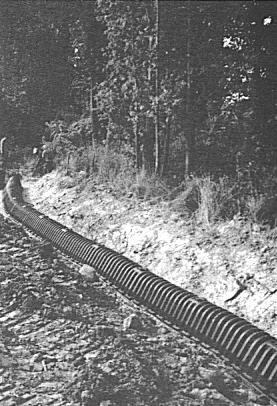







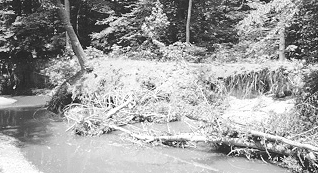
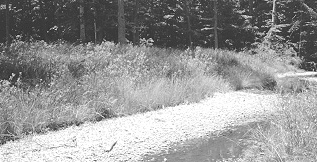

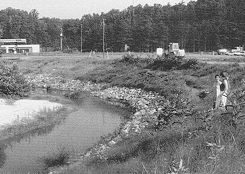
 Schematic of three zone urban stream buffer system (Schueler 1995d)
Schematic of three zone urban stream buffer system (Schueler 1995d)




















